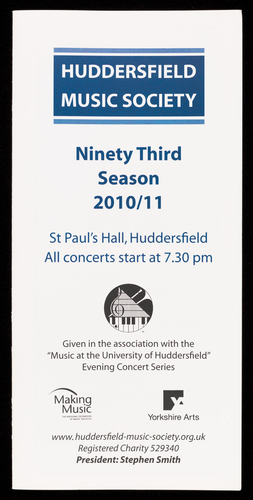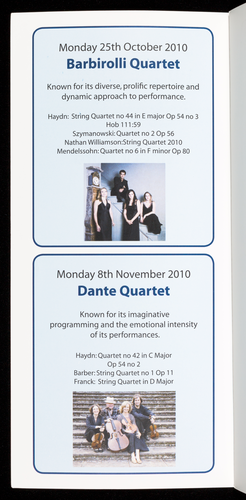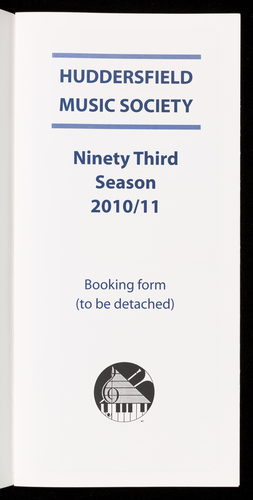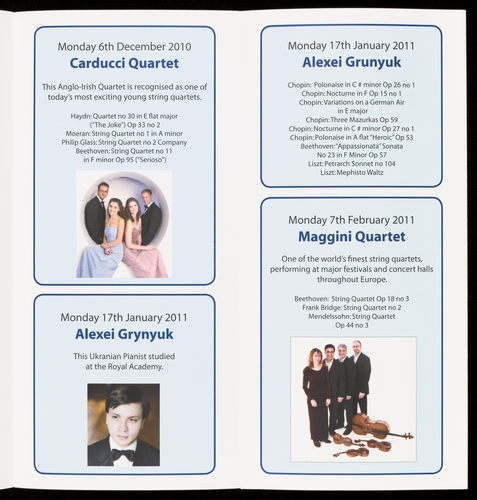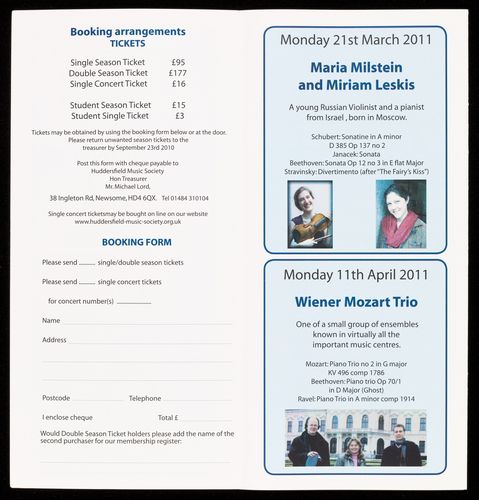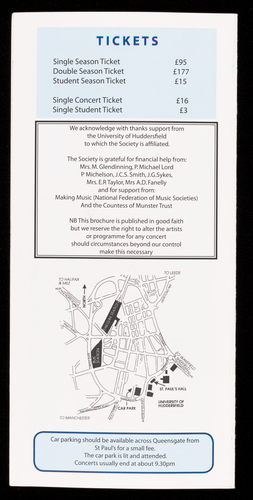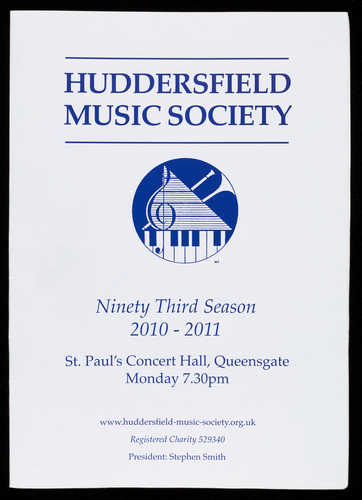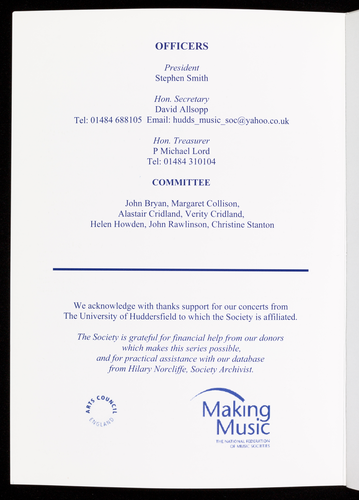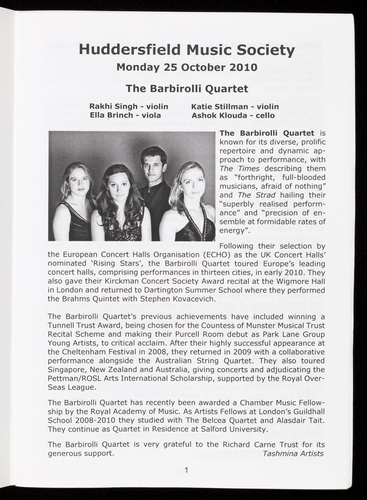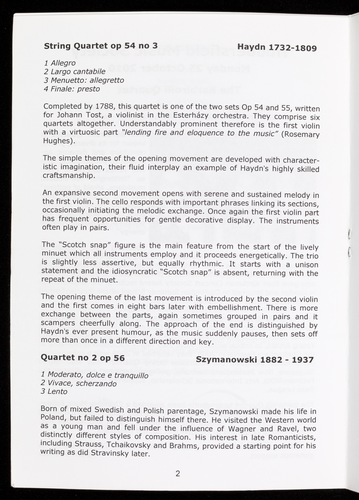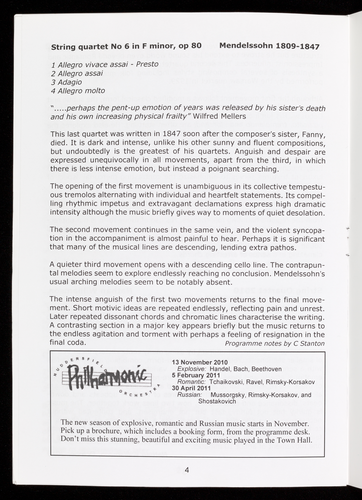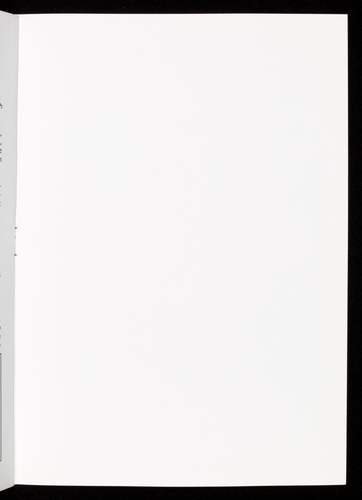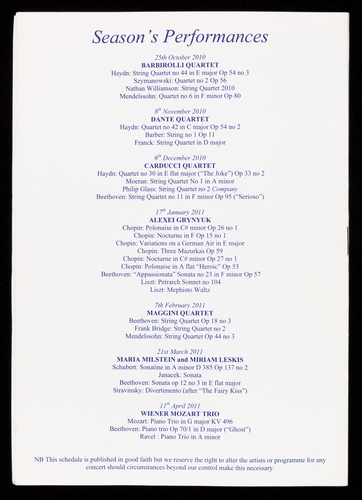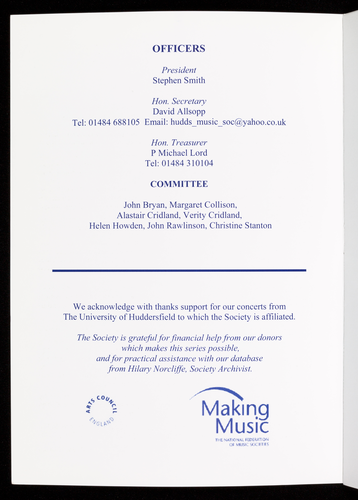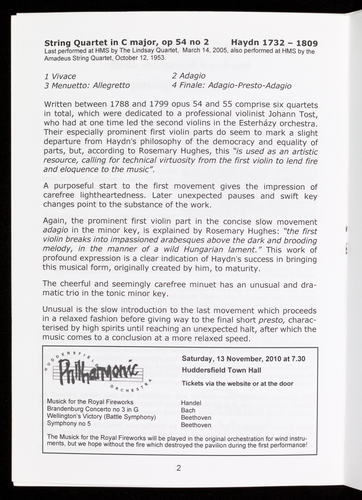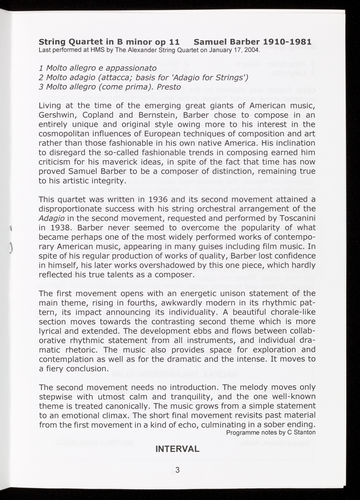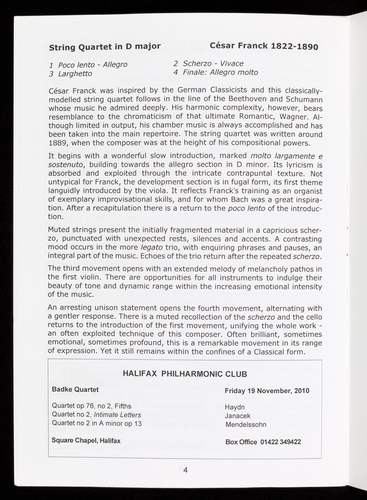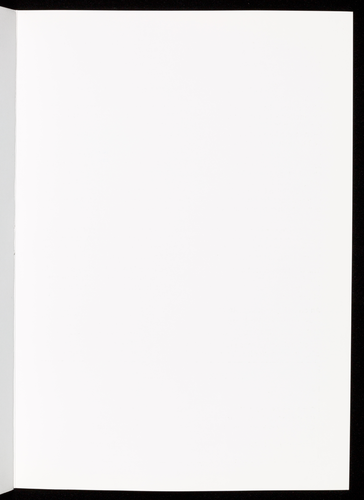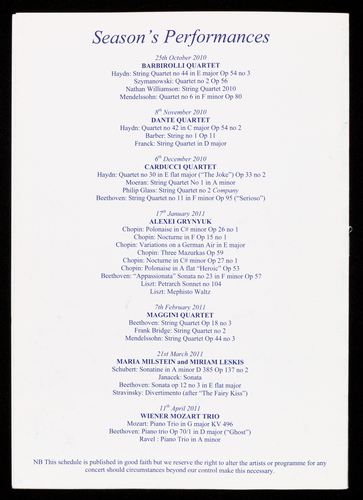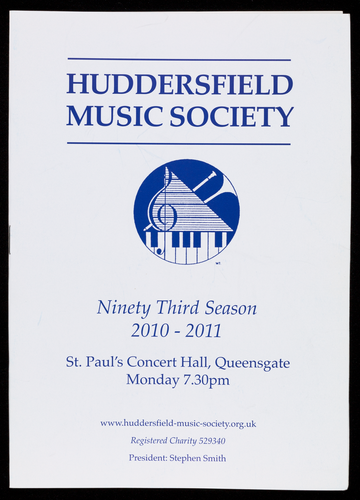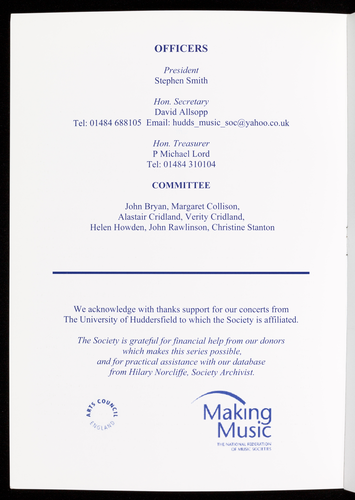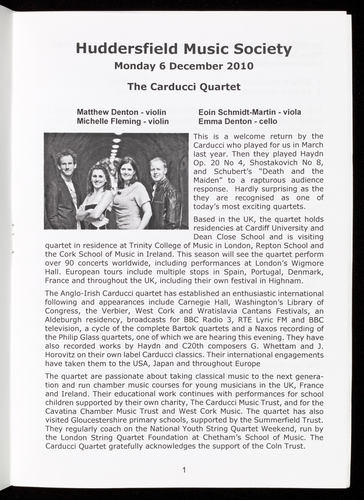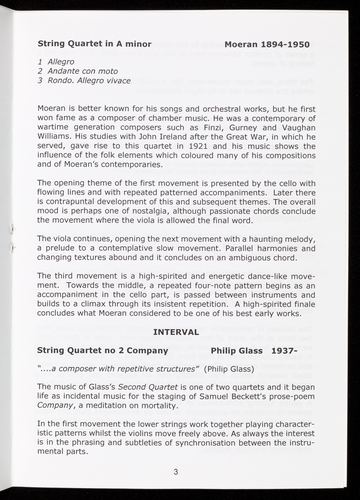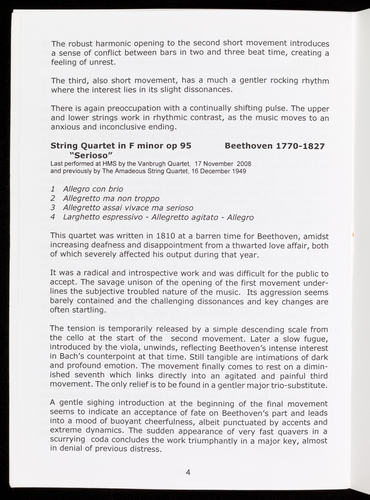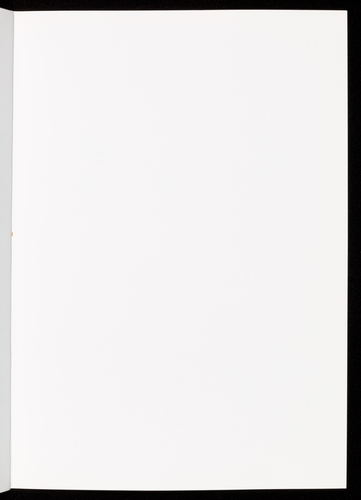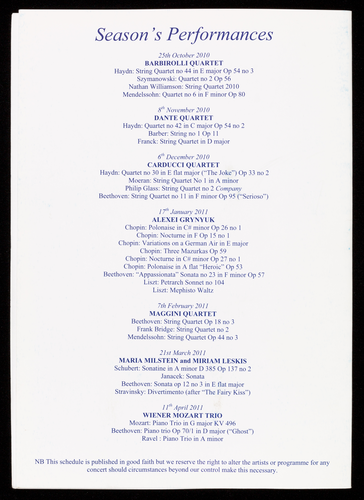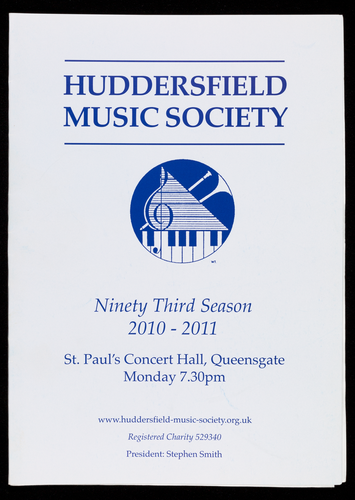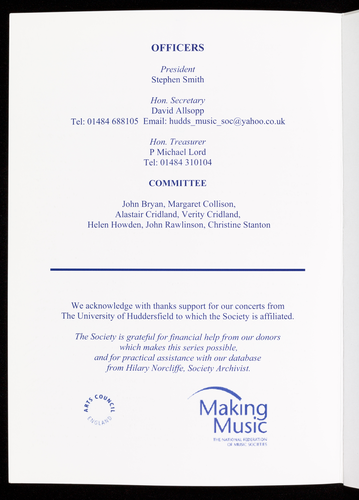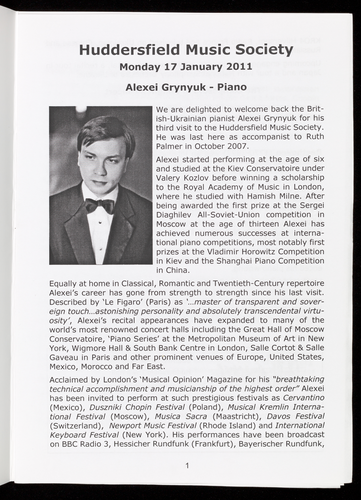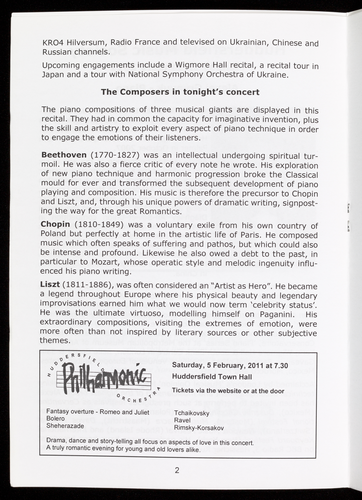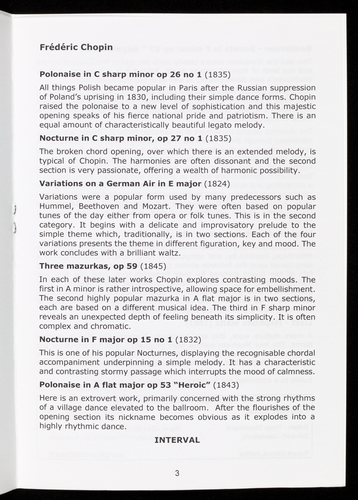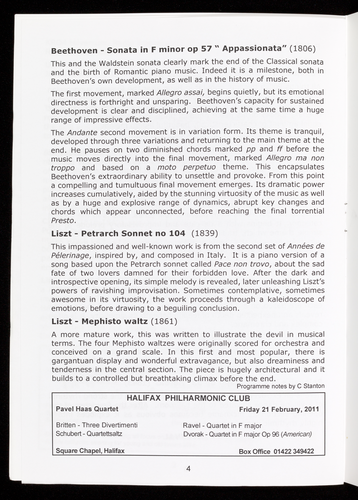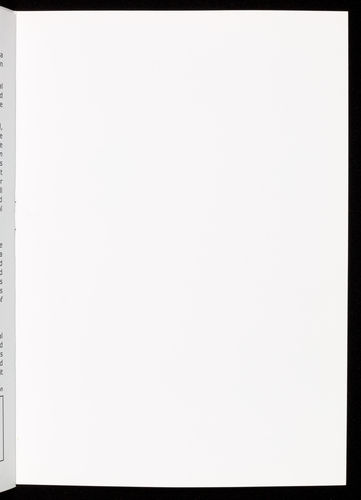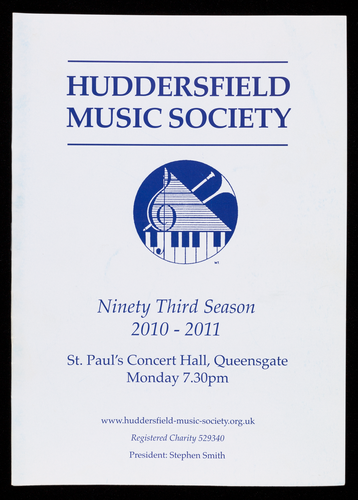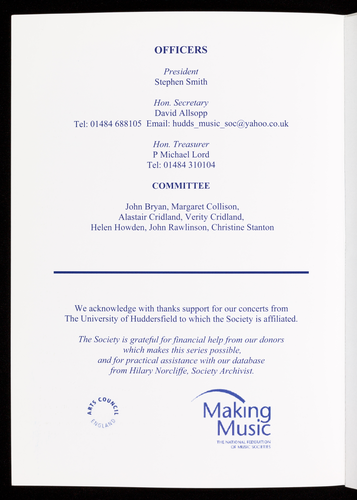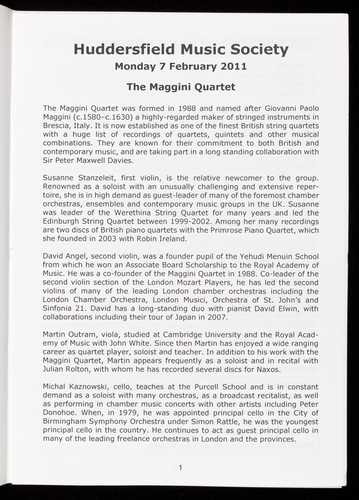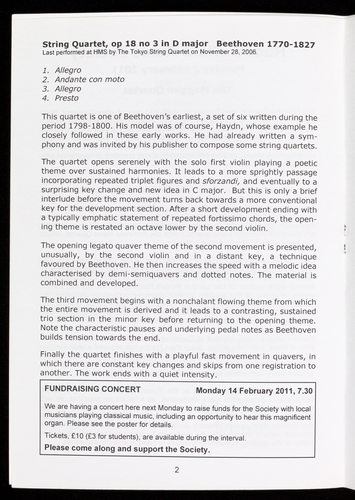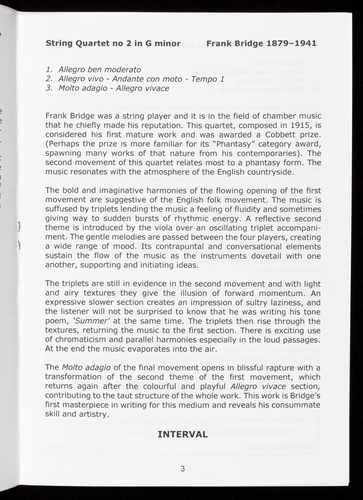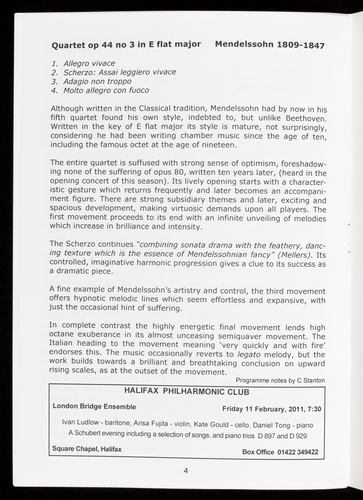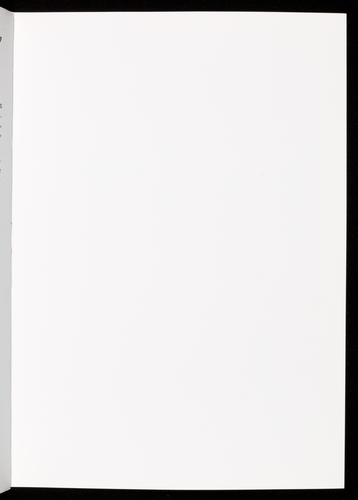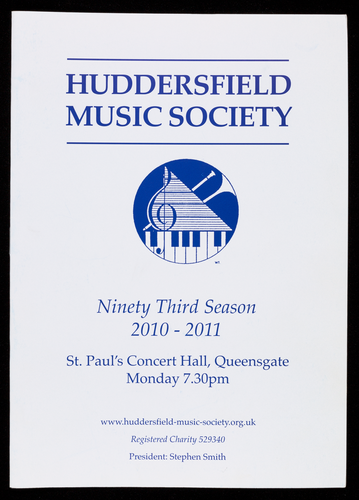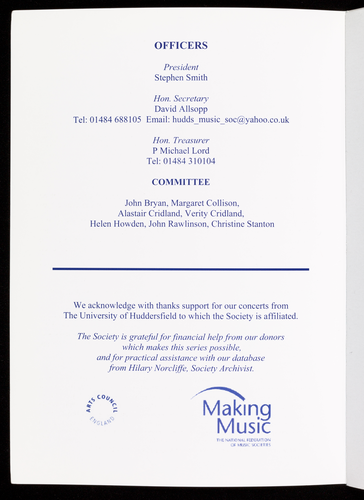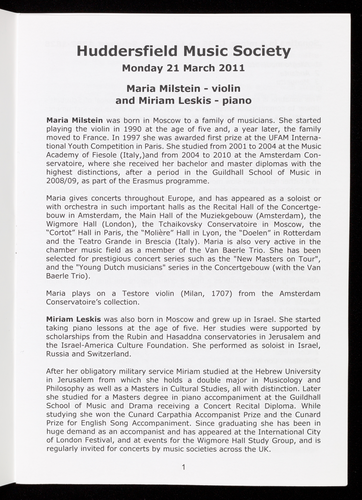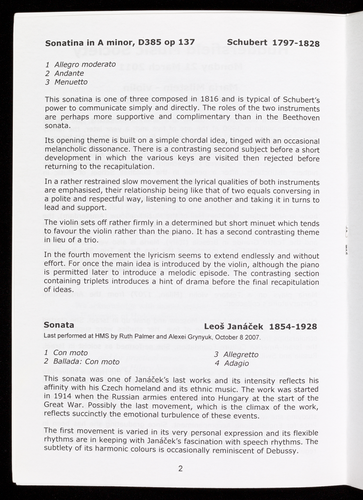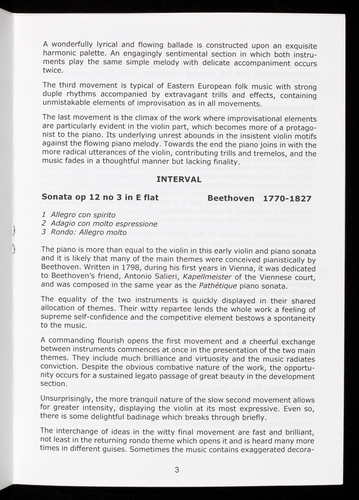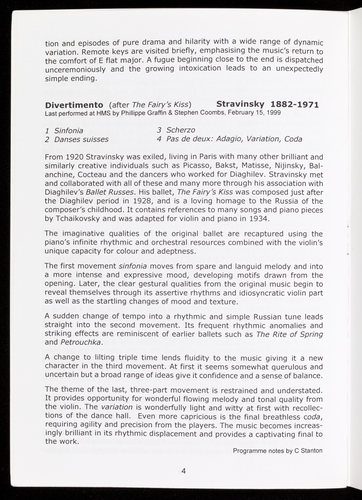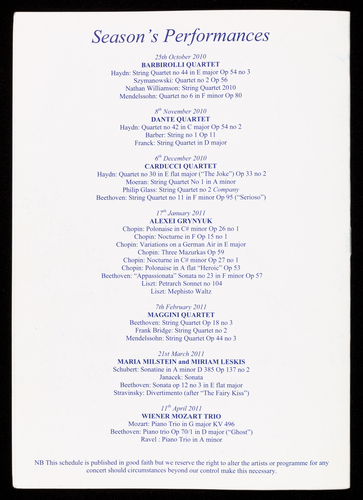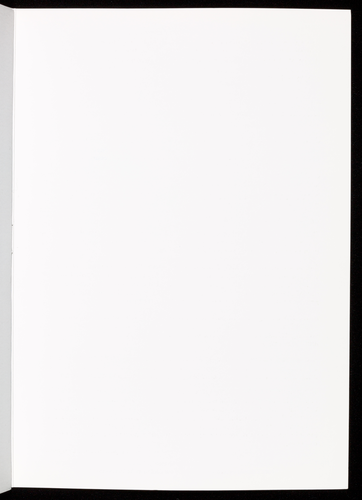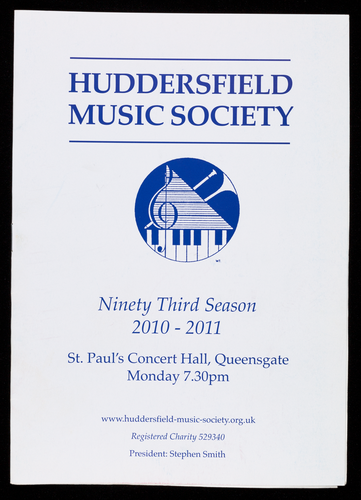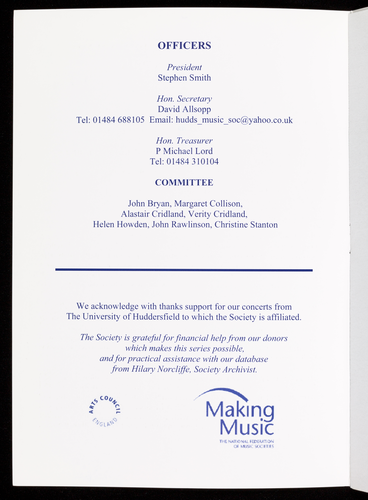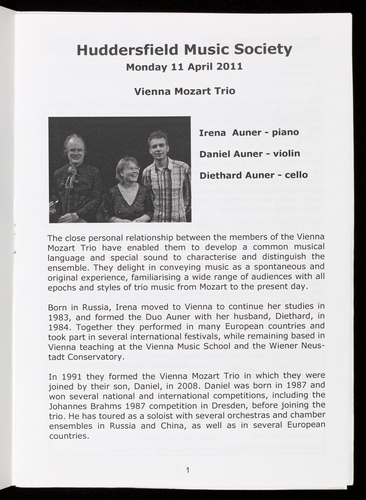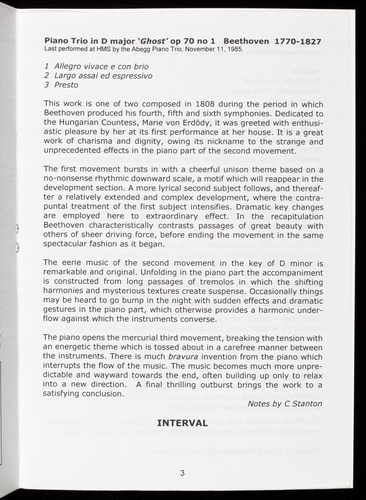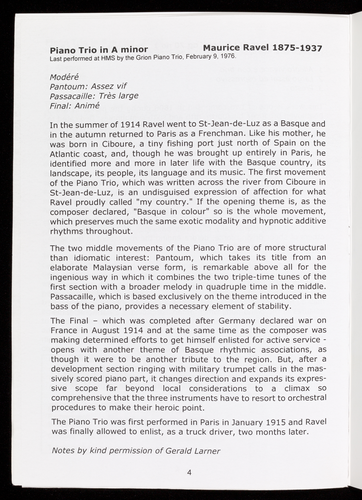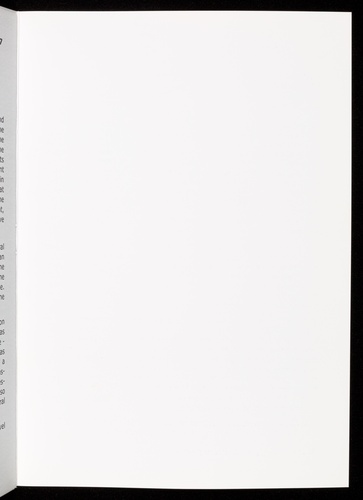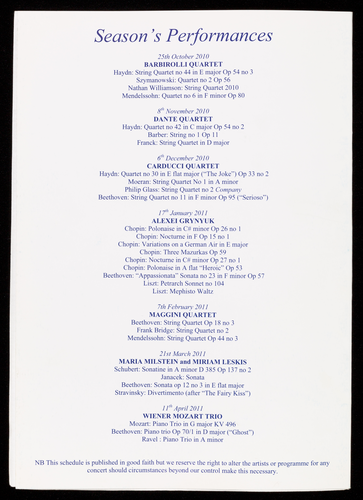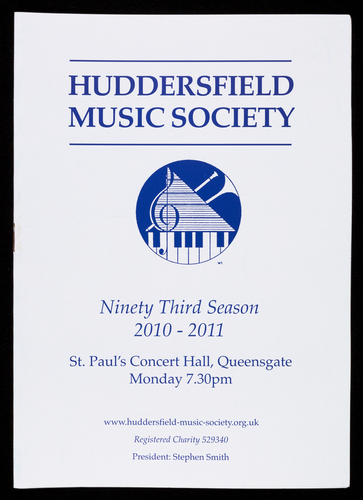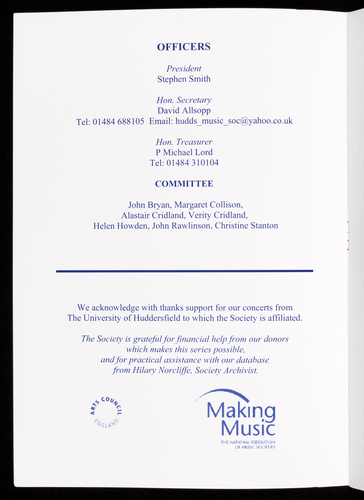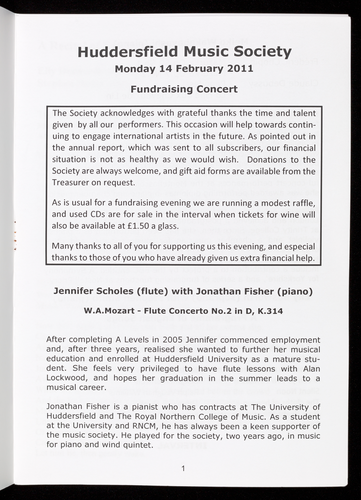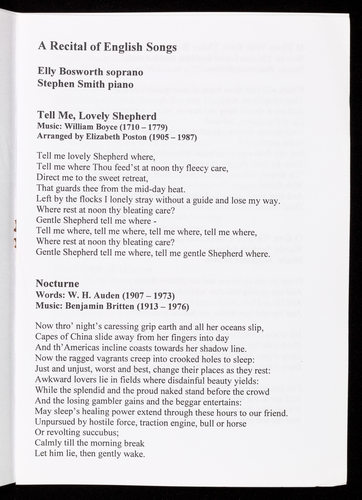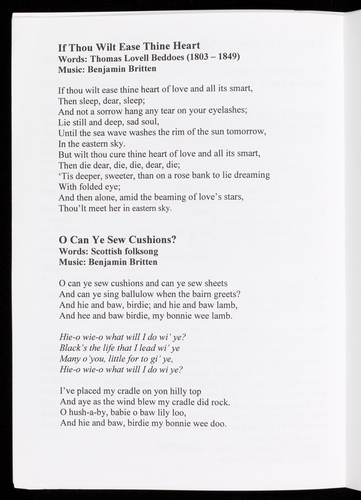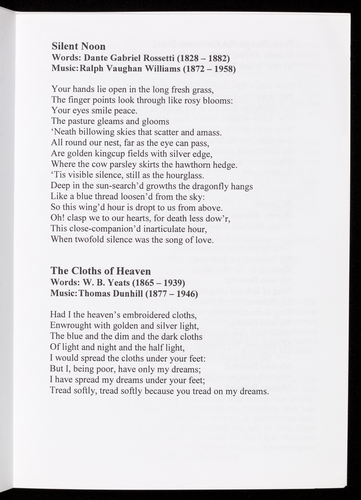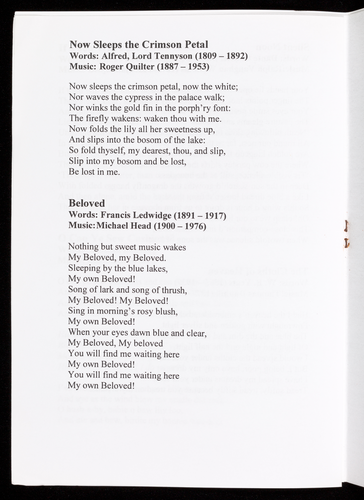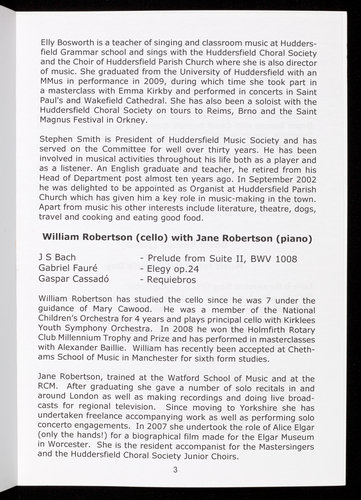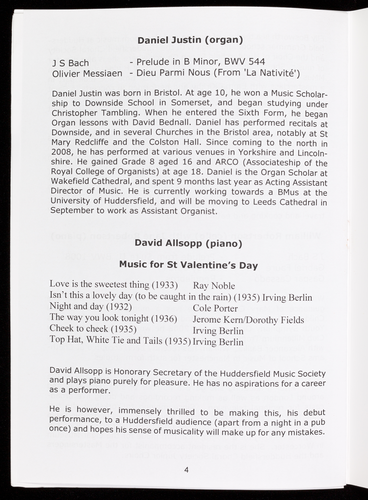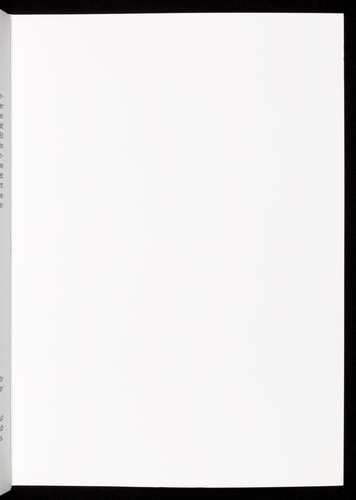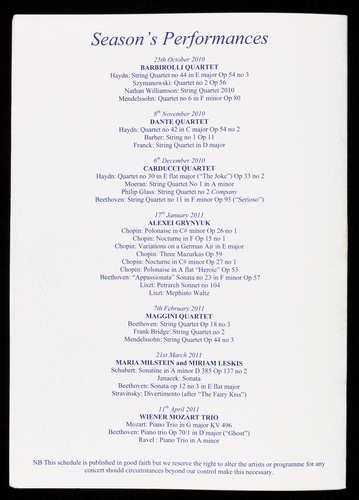Ocr'd Text:
HUDDERSFIELD
MUSIC SOCIETY
Ninety Third
Season
2010/11
St Paul's Hall, Huddersfield
All concerts start at 7.30 pm
Given in the association with the
"Music at the University of Huddersfield"
Evening Concert Series
Making
Music
WT.
THE NATIONAL FEDERATION
OF MUSIC SOCIETIES
Yorkshire Arts
www.huddersfield-music-society.org.uk
Registered Charity 529340
President: Stephen Smith
Ocr'd Text:
Monday 25th October 2010
Barbirolli Quartet
Known for its diverse, prolific repertoire and
dynamic approach to performance.
Haydn: String Quartet no 44 in E major Op 54 no 3
Hob 111:59
Szymanowski: Quartet no 2 Op 56
Nathan Williamson:String Quartet 2010
Mendelssohn: Quartet no 6 in F minor Op 80
Monday 8th November 2010
Dante Quartet
Known for its imaginative
programming and the emotional intensity
of its performances.
Haydn: Quartet no 42 in C Major
Op 54 no 2
Barber: String Quartet no 1 Op 11
Franck: String Quartet in D Major
0
Ocr'd Text:
HUDDERSFIELD
MUSIC SOCIETY
Ninety Third
Season
2010/11
Booking form
(to be detached)
WT.
Ocr'd Text:
Monday 6th December 2010
Carducci Quartet
This Anglo-Irish Quartet is recognised as one of
today's most exciting young string quartets.
Haydn: Quartet no 30 in E flat major
("The Joke") Op 33 no 2
Moeran: String Quartet no 1 in A minor
Philip Glass: String Quartet no 2 Company
Beethoven: String Quartet no 11
in F minor Op 95 ("Serioso")
Monday 17th January 2011
Alexei Grynyuk
This Ukranian Pianist studied
at the Royal Academy.
Monday 17th January 2011
Alexei Grunyuk
Chopin: Polonaise in C # minor Op 26 no 1
Chopin: Nocturne in F Op 15 no 1
Chopin: Variations on a German Air
in E major
Chopin: Three Mazurkas Op 59
Chopin: Nocturne in C # minor Op 27 no 1
Chopin: Polonaise in A flat "Heroic" Op 53
Beethoven:"Appassionata" Sonata
No 23 in F Minor Op 57
Liszt: Petrarch Sonnet no 104
Liszt: Mephisto Waltz
Monday 7th February 2011
Maggini Quartet
One of the world's finest string quartets,
performing at major festivals and concert halls
throughout Europe.
Beethoven: String Quartet Op 18 no 3
Frank Bridge: String Quartet no 2
Mendelssohn: String Quartet
Op 44 no 3
Ocr'd Text:
Booking arrangements
TICKETS
Single Season Ticket
Double Season Ticket
Single Concert Ticket
Student Season Ticket
Student Single Ticket
Tickets may be obtained by using the booking form below or at the door.
Please return unwanted season tickets to the
treasurer by September 23rd 2010
Post this form with cheque payable to
Huddersfield Music Society
Hon Treasurer
Mr. Michael Lord,
38 Ingleton Rd, Newsome, HD4 6QX. Tel 01484 310104
Name
Single concert ticketsmay be bought on line on our website
www.huddersfield-music-society.org.uk
Address
Please send .…........... single concert tickets
£95
£177
£16
Please send .….......... single/double season tickets
for concert number(s) .…..….……….…..
Postcode
BOOKING FORM
£15
£3
Telephone
I enclose cheque
Would Double Season Ticket holders please add the name of the
second purchaser for our membership register:
Total £
Monday 21st March 2011
Maria Milstein
and Miriam Leskis
A young Russian Violinist and a pianist
from Israel, born in Moscow.
Schubert: Sonatine in A minor
D 385 Op 137 no 2
Janacek: Sonata
Beethoven: Sonata Op 12 no 3 in E flat Major
Stravinsky: Divertimento (after "The Fairy's Kiss")
Monday 11th April 2011
Wiener Mozart Trio
One of a small group of ensembles
known in virtually all the
important music centres.
Mozart: Piano Trio no 2 in G major
KV 496 comp 1786
Beethoven: Piano trio Op 70/1
in D Major (Ghost)
Ravel: Piano Trio in A minor comp 1914
Ocr'd Text:
Single Season Ticket
Double Season Ticket
Student Season Ticket
Single Concert Ticket
Single Student Ticket
THP
TICKETS
We acknowledge with thanks support from
the University of Huddersfield
to which the Society is affiliated.
The Society is grateful for financial help from:
Mrs. M. Glendinning, P. Michael Lord
P Michelson, J.C.S. Smith, J.G.Sykes,
Mrs.E.R Taylor, Mrs A.D. Fanelly
and for support from:
Making Music (National Federation of Music Societies)
And the Countess of Munster Trust
NEW NORT
NORTH
NB This brochure is published in good faith
but we reserve the right to alter the artists
or programme for any concert
should circumstances beyond our control
make this necessary
CASTLE CATE
BUS
TO MANCHESTER
ASZ MANOMETER ROAD
RAILWAY STATION
HDD
1000元
00000
On
000
001
£95
£177
£15
30
T
QUEESAGATE
£16
£3
CAR PARK
TO LEEDS
TO WAKEFIELD
29 WAKEFIELD ROAD
ST. PAUL'S HALL
The car park is lit and attended.
Concerts usually end at about 9.30pm
UNIVERSITY OF
HUDDERSFIELD
Car parking should be available across Queensgate from
St Paul's for a small fee.
Ocr'd Text:
HUDDERSFIELD
MUSIC SOCIETY
||
I
T
WT.
Ninety Third Season
2010 - 2011
St. Paul's Concert Hall, Queensgate
Monday 7.30pm
www.huddersfield-music-society.org.uk
Registered Charity 529340
President: Stephen Smith
Ocr'd Text:
Hon. Secretary
David Allsopp
Tel: 01484 688105 Email: hudds_music_soc@yahoo.co.uk
OFFICERS
SINN
President
Stephen Smith
John Bryan, Margaret Collison,
Alastair Cridland, Verity Cridland,
Helen Howden, John Rawlinson, Christine Stanton
TS
We acknowledge with thanks support for our concerts from
The University of Huddersfield to which the Society is affiliated.
COUNCIL
Hon. Treasurer
P Michael Lord
Tel: 01484 310104
The Society is grateful for financial help from our donors
which makes this series possible,
and for practical assistance with our database
from Hilary Norcliffe, Society Archivist.
ENGLAND
COMMITTEE
Making
Music
THE NATIONAL FEDERATION
Ocr'd Text:
Huddersfield Music Society
Monday 25 October 2010
The Barbirolli Quartet
Rakhi Singh - violin
Ella Brinch - viola
Katie Stillman - violin
Ashok Klouda - cello
The Barbirolli Quartet is
known for its diverse, prolific
repertoire and dynamic ap-
proach to performance, with
The Times describing them
as "forthright, full-blooded
musicians, afraid of nothing"
and The Strad hailing their
"superbly realised perform-
ance" and "precision of en-
semble at formidable rates of
energy".
Following their selection by
the European Concert Halls Organisation (ECHO) as the UK Concert Halls'
nominated 'Rising Stars', the Barbirolli Quartet toured Europe's leading
concert halls, comprising performances in thirteen cities, in early 2010. They
also gave their Kirckman Concert Society Award recital at the Wigmore Hall
in London and returned to Dartington Summer School where they performed
the Brahms Quintet with Stephen Kovacevich.
The Barbirolli Quartet's previous achievements have included winning a
Tunnell Trust Award, being chosen for the Countess of Munster Musical Trust
Recital Scheme and making their Purcell Room debut as Park Lane Group
Young Artists, to critical acclaim. After their highly successful appearance at
the Cheltenham Festival in 2008, they returned in 2009 with a collaborative
performance alongside the Australian String Quartet. They also toured
Singapore, New Zealand and Australia, giving concerts and adjudicating the
Pettman/ROSL Arts International Scholarship, supported by the Royal Over-
Seas League.
The Barbirolli Quartet has recently been awarded a Chamber Music Fellow-
ship by the Royal Academy of Music. As Artists Fellows at London's Guildhall
School 2008-2010 they studied with The Belcea Quartet and Alasdair Tait.
They continue as Quartet in Residence at Salford University.
1
The Barbirolli Quartet is very grateful to the Richard Carne Trust for its
generous support.
Tashmina Artists
Ocr'd Text:
String Quartet op 54 no 3
1 Allegro
2 Largo cantabile
3 Menuetto: allegretto
4 Finale: presto
Haydn 1732-1809
Completed by 1788, this quartet is one of the two sets Op 54 and 55, written
for Johann Tost, a violinist in the Esterházy orchestra. They comprise six
quartets altogether. Understandably prominent therefore is the first violin
with a virtuosic part "lending fire and eloquence to the music" (Rosemary
Hughes).
The simple themes of the opening movement are developed with character-
istic imagination, their fluid interplay an example of Haydn's highly skilled
craftsmanship.
An expansive second movement opens with serene and sustained melody in
the first violin. The cello responds with important phrases linking its sections,
occasionally initiating the melodic exchange. Once again the first violin part
has frequent opportunities for gentle decorative display. The instruments
often play in pairs.
The "Scotch snap" figure is the main feature from the start of the lively
minuet which all instruments employ and it proceeds energetically. The trio
is slightly less assertive, but equally rhythmic. It starts with a unison
statement and the idiosyncratic "Scotch snap" is absent, returning with the
repeat of the minuet.
The opening theme of the last movement is introduced by the second violin
and the first comes in eight bars later with embellishment. There is more
exchange between the parts, again sometimes grouped in pairs and it
scampers cheerfully along. The approach of the end is distinguished by
Haydn's ever present humour, as the music suddenly pauses, then sets off
more than once in a different direction and key.
Quartet no 2 op 56
1 Moderato, dolce e tranquillo
2 Vivace, scherzando
3 Lento
2
Szymanowski 1882 - 1937
Born of mixed Swedish and Polish parentage, Szymanowski made his life in
Poland, but failed to distinguish himself there. He visited the Western world
as a young man and fell under the influence of Wagner and Ravel, two
distinctly different styles of composition. His interest in late Romanticists,
including Strauss, Tchaikovsky and Brahms, provided a starting point for his
writing as did Stravinsky later.
Ocr'd Text:
Szymanowski's quartets are very much in the Classical tradition regarding
structure but he strove to extend his sound world even beyond Romantic and
Impressionist influences. This second quartet, composed in 1927, is therefore
a synthesis of several composing styles including folk music. It was first
performed by the Warsaw quartet in 1929.
Although the first movement follows a modified classical form, the subtle and
seductive colours of the opening accompaniment have strong affiliations with
Debussy. His luminous textures and unique colour palettes, combined with
pizzicato, tremolando and sforzandi are often startling. He also explores the
extreme ranges of dynamics and pitch. The sensuous and mysterious tex-
tures of the opening lead into a world of musical contrasts.
The second movement is instantly sparkling and lives up to the scherzando
title, meaning playful or a joke. A shift later toward contemplative and
luxuriant textures serves to emphasize the contrasting mercurial aspect of
the opening.
Szymanowksi acknowledged the inspiration of the Southern mountains of
Poland named the Tatra, and his fugal subjects in the last movement are built
from the region's haunting folk themes. His use of fugue form is not unprec-
edented, providing unmistakable evidence of inspiration from Bartok and
Stravinsky. The central section once again explores unusual combinations of
sound and effects. It's speed and dramatic power build towards the end,
climaxing in a series of arresting chords.
INTERVAL
String Quartet 2010
Nathan Williamson
In writing this Quartet I wanted to explore the tension in creating a work for
the most objective of Western ensembles for which have been composed so
many profound and deeply personal works. To compose for quartet is an
Apollo/Dionysus head/heart dichotomy which is infinitely taxing and exciting.
I decided to reflect this conundrum by using many contradictory ideas in a lot
of smaller sections to create an overall arch-form, combining a stop-start feel
with a sense of direction and a very wide variety of different styles, tempi,
emotional affects and ideas, all of which are related but are separate. Some
of these are repeated, some are developed and others are neither. They are
all based on the simple, objective features of music - upbeats and down-
beats, dissonance and consonance, how two lines work together. The music
is quirky but not funny, fast but not energised, and contented without
necessarily being cheerful, and overall has a great sense of loneliness -
composing is a solitary occupation, after all while at the same time being
fairly light-hearted, or, at least, certainly not sad or serious. The piece is in
one movement of about 10 minutes.
Nathan Williamson, October 2010
3
-
Ocr'd Text:
String quartet No 6 in F minor, op 80
1 Allegro vivace assai - Presto
2 Allegro assai
3 Adagio
4 Allegro molto
".....perhaps the pent-up emotion of years was released by his sister's death
and his own increasing physical frailty" Wilfred Mellers
This last quartet was written in 1847 soon after the composer's sister, Fanny,
died. It is dark and intense, unlike his other sunny and fluent compositions,
but undoubtedly is the greatest of his quartets. Anguish and despair are
expressed unequivocally in all movements, apart from the third, in which
there is less intense emotion, but instead a poignant searching.
The opening of the first movement is unambiguous in its collective tempestu-
ous tremolos alternating with individual and heartfelt statements. Its compel-
ling rhythmic impetus and extravagant declamations express high dramatic
intensity although the music briefly gives way to moments of quiet desolation.
The second movement continues in the same vein, and the violent syncopa-
tion in the accompaniment is almost painful to hear. Perhaps it is significant
that many of the musical lines are descending, lending extra pathos.
Mendelssohn 1809-1847
A quieter third movement opens with a descending cello line. The contrapun-
tal melodies seem to explore endlessly reaching no conclusion. Mendelssohn's
usual arching melodies seem to be notably absent.
The intense anguish of the first two movements returns to the final move-
ment. Short motivic ideas are repeated endlessly, reflecting pain and unrest.
Later repeated dissonant chords and chromatic lines characterise the writing.
A contrasting section in a major key appears briefly but the music returns to
the endless agitation and torment with perhaps a feeling of resignation in the
final coda.
Programme notes by C Stanton
an H
ERSFI
Philharmonic
ORCHES
13 November 2010
Explosive: Handel, Bach, Beethoven
5 February 2011
Romantic: Tchaikovski, Ravel, Rimsky-Korsakov
30 April 2011
Russian: Mussorgsky, Rimsky-Korsakov, and
Shostakovich
The new season of explosive, romantic and Russian music starts in November.
Pick up a brochure, which includes a booking form, from the programme desk.
Don't miss this stunning, beautiful and exciting music played in the Town Hall.
4
Ocr'd Text:
Season's Performances
25th October 2010
BARBIROLLI QUARTET
Haydn: String Quartet no 44 in E major Op 54 no 3
Szymanowski: Quartet no 2 Op 56
Nathan Williamson: String Quartet 2010
Mendelssohn: Quartet no 6 in F minor Op 80
8th November 2010
DANTE QUARTET
Haydn: Quartet no 42 in C major Op 54 no 2
Barber: String no 1 Op 11
Franck: String Quartet in D major
6th December 2010
CARDUCCI QUARTET
Haydn: Quartet no 30 in E flat major ("The Joke") Op 33 no 2
Moeran: String Quartet No 1 in A minor
Philip Glass: String Quartet no 2 Company
Beethoven: String Quartet no 11 in F minor Op 95 ("Serioso")
17th January 2011
ALEXEI GRYNYUK
Chopin: Polonaise in C# minor Op 26 no 1
Chopin: Nocturne in F Op 15 no 1
Chopin: Variations on a German Air in E major
Chopin: Three Mazurkas Op 59
Chopin: Nocturne in C# minor Op 27 no 1
Chopin: Polonaise in A flat "Heroic" Op 53
Beethoven: "Appassionata" Sonata no 23 in F minor Op 57
Liszt: Petrarch Sonnet no 104
Liszt: Mephisto Waltz
7th February 2011
MAGGINI QUARTET
Beethoven: String Quartet Op 18 no 3
Frank Bridge: String Quartet no 2
Mendelssohn: String Quartet Op 44 no 3
21st March 2011
MARIA MILSTEIN and MIRIAM LESKIS
Schubert: Sonatine in A minor D 385 Op 137 no 2
Janacek: Sonata
Beethoven: Sonata op 12 no 3 in E flat major
Stravinsky: Divertimento (after "The Fairy Kiss")
11th April 2011
WIENER MOZART TRIO
Mozart: Piano Trio in G major KV 496
Beethoven: Piano trio Op 70/1 in D major ("Ghost")
Ravel: Piano Trio in A minor
NB This schedule is published in good faith but we reserve the right to alter the artists or programme for any
concert should circumstances beyond our control make this necessary.
Ocr'd Text:
HUDDERSFIELD
MUSIC SOCIETY
1
W IL
I
WT.
Ninety Third Season
2010 - 2011
St. Paul's Concert Hall, Queensgate
Monday 7.30pm
www.huddersfield-music-society.org.uk
Registered Charity 529340
President: Stephen Smith
Ocr'd Text:
Hon. Secretary
David Allsopp
Tel: 01484 688105 Email: hudds_music_soc@yahoo.co.uk
OFFICERS
President
Stephen Smith
John Bryan, Margaret Collison,
Alastair Cridland, Verity Cridland,
Helen Howden, John Rawlinson, Christine Stanton
ARTS
Hon. Treasurer
P Michael Lord
Tel: 01484 310104
We acknowledge with thanks support for our concerts from
The University of Huddersfield to which the Society is affiliated.
COUNCIL
COMMITTEE
The Society is grateful for financial help from our donors
which makes this series possible,
and for practical assistance with our database
from Hilary Norcliffe, Society Archivist.
ENGLAND
Making
Music
THE NATIONAL FEDERATION
Ocr'd Text:
Huddersfield Music Society
Monday 8 November 2010
The Dante Quartet
Krysia Osostowicz - violin
Judith Busbridge - viola
Giles Francis - violin
Bernard Gregor-Smith - cello
Winner of the prestigious Royal Philhar-
monic Society Award for best chamber
ensemble in 2007, the Dante Quartet is
known for its imaginative programming
and the emotional intensity of its per-
formances. The group was founded in
1995 at the International Musicians
Seminar at Prussia Cove, Cornwall, and
chose the name of Dante to reflect the
idea of a great and challenging journey.
The Dante Quartet plays at major con-
cert halls, music societies and festivals
throughout the UK, and in the past two
years has appeared at the Aldeburgh, Bath, Cheltenham and City of London
Festivals as well as London's Wigmore Hall and Kings Place. The quartet broadcasts
regularly on BBC Radio 3 and has also performed in France, Germany, Holland,
Spain, Switzerland, Poland and Finland. In August 2009 the Quartet was featured
at the Paunat Festival in France.
Last year the Dante Quartet's Hyperion recording of Franck and Fauré's string
quartets was honoured with a BBC Music Magazine Award in the UK. The quartet's
latest recording for Hyperion, of Debussy and Ravel's quartets, is attracting enthu-
siastic reviews.
The Dante Quartet enjoys a special association with King's College, Cambridge,
including master-classes, collaborations with the renowned King's College Choir and
quartet concerts including poetry readings. The Quartet has taught at the Guildhall
School of Music and Drama, at Dartington and Cadenza Summer Schools and in
Spain, and worked in association with the pioneering Cavatina Chamber Music
Trust. Concert engagements are often combined with open rehearsals or workshops
for young people, and the Dante Quartet also offers special programmes to children
in schools who might never otherwise hear live classical music.
The Quartet recently commissioned and premiered five new works inspired by
Dante, under the title of the Divine Comedy Project, by Roxanna Panufnik, Cheryl
Frances-Hoad, Dmitri Smirnov and Elena and Alissa Firsova.
1
Plans for 2010 include a CD of quartets by Sibelius and Smetana, concerts in the
Czech Republic and the Netherlands, and further projects at King's College, Cam-
bridge.
www.dantequartet.org
Ocr'd Text:
String Quartet in C major, op 54 no 2
Haydn 1732 - 1809
Last performed at HMS by The Lindsay Quartet, March 14, 2005, also performed at HMS by the
Amadeus String Quartet, October 12, 1953.
1 Vivace
3 Menuetto: Allegretto
2 Adagio
4 Finale: Adagio-Presto-Adagio
Written between 1788 and 1799 opus 54 and 55 comprise six quartets
in total, which were dedicated to a professional violinist Johann Tost,
who had at one time led the second violins in the Esterházy orchestra.
Their especially prominent first violin parts do seem to mark a slight
departure from Haydn's philosophy of the democracy and equality of
parts, but, according to Rosemary Hughes, this "is used as an artistic
resource, calling for technical virtuosity from the first violin to lend fire
and eloquence to the music".
A purposeful start to the first movement gives the impression of
carefree lightheartedness. Later unexpected pauses and swift key
changes point to the substance of the work.
Again, the prominent first violin part in the concise slow movement
adagio in the minor key, is explained by Rosemary Hughes: "the first
violin breaks into impassioned arabesques above the dark and brooding
melody, in the manner of a wild Hungarian lament." This work of
profound expression is a clear indication of Haydn's success in bringing
this musical form, originally created by him, to maturity.
The cheerful and seemingly carefree minuet has an unusual and dra-
matic trio in the tonic minor key.
Unusual is the slow introduction to the last movement which proceeds
in a relaxed fashion before giving way to the final short presto, charac-
terised by high spirits until reaching an unexpected halt, after which the
music comes to a conclusion at a more relaxed speed.
UDDERSFI
Philharmonic
ORCHEST
Musick for the Royal Fireworks
Brandenburg Concerto no 3 in G
Wellington's Victory (Battle Symphony)
Symphony no 5
Saturday, 13 November, 2010 at 7.30
Huddersfield Town Hall
Tickets via the website or at the door
Handel
Bach
2
Beethoven
Beethoven
The Musick for the Royal Fireworks will be played in the original orchestration for wind instru-
ments, but we hope without the fire which destroyed the pavilion during the first performance!
Ocr'd Text:
Y
J
String Quartet in B minor op 11 Samuel Barber 1910-1981
Last performed at HMS by The Alexander String Quartet on January 17, 2004.
1 Molto allegro e appassionato
2 Molto adagio (attacca; basis for 'Adagio for Strings')
3 Molto allegro (come prima). Presto
Living at the time of the emerging great giants of American music,
Gershwin, Copland and Bernstein, Barber chose to compose in an
entirely unique and original style owing more to his interest in the
cosmopolitan influences of European techniques of composition and art
rather than those fashionable in his own native America. His inclination
to disregard the so-called fashionable trends in composing earned him
criticism for his maverick ideas, in spite of the fact that time has now
proved Samuel Barber to be a composer of distinction, remaining true
to his artistic integrity.
This quartet was written in 1936 and its second movement attained a
disproportionate success with his string orchestral arrangement of the
Adagio in the second movement, requested and performed by Toscanini
in 1938. Barber never seemed to overcome the popularity of what
became perhaps one of the most widely performed works of contempo-
rary American music, appearing in many guises including film music. In
spite of his regular production of works of quality, Barber lost confidence
in himself, his later works overshadowed by this one piece, which hardly
reflected his true talents as a composer.
The first movement opens with an energetic unison statement of the
main theme, rising in fourths, awkwardly modern in its rhythmic pat-
tern, its impact announcing its individuality. A beautiful chorale-like
section moves towards the contrasting second theme which is more
lyrical and extended. The development ebbs and flows between collab-
orative rhythmic statement from all instruments, and individual dra-
matic rhetoric. The music also provides space for exploration and
contemplation as well as for the dramatic and the intense. It moves to
a fiery conclusion.
The second movement needs no introduction. The melody moves only
stepwise with utmost calm and tranquility, and the one well-known
theme is treated canonically. The music grows from a simple statement
to an emotional climax. The short final movement revisits past material
from the first movement in a kind of echo, culminating in a sober ending.
Programme notes by C Stanton
INTERVAL
3
Ocr'd Text:
String Quartet in D major
1 Poco lento - Allegro
3 Larghetto
César Franck was inspired by the German Classicists and this classically-
modelled string quartet follows in the line of the Beethoven and Schumann
whose music he admired deeply. His harmonic complexity, however, bears
resemblance to the chromaticism of that ultimate Romantic, Wagner. Al-
though limited in output, his chamber music is always accomplished and has
been taken into the main repertoire. The string quartet was written around
1889, when the composer was at the height of his compositional powers.
César Franck 1822-1890
2 Scherzo - Vivace
4 Finale: Allegro molto
It begins with a wonderful slow introduction, marked molto largamente e
sostenuto, building towards the allegro section in D minor. Its lyricism is
absorbed and exploited through the intricate contrapuntal texture. Not
untypical for Franck, the development section is in fugal form, its first theme
languidly introduced by the viola. It reflects Franck's training as an organist
of exemplary improvisational skills, and for whom Bach was a great inspira-
tion. After a recapitulation there is a return to the poco lento of the introduc-
tion.
Muted strings present the initially fragmented material in a capricious scher-
zo, punctuated with unexpected rests, silences and accents. A contrasting
mood occurs in the more legato trio, with enquiring phrases and pauses, an
integral part of the music. Echoes of the trio return after the repeated scherzo.
The third movement opens with an extended melody of melancholy pathos in
the first violin. There are opportunities for all instruments to indulge their
beauty of tone and dynamic range within the increasing emotional intensity
of the music.
Badke Quartet
An arresting unison statement opens the fourth movement, alternating with
a gentler response. There is a muted recollection of the scherzo and the cello
returns to the introduction of the first movement, unifying the whole work -
an often exploited technique of this composer. Often brilliant, sometimes
emotional, sometimes profound, this is a remarkable movement in its range
of expression. Yet it still remains within the confines of a Classical form.
Quartet op 76, no 2, Fifths
Quartet no 2, Intimate Letters
Quartet no 2 in A minor op 13
Square Chapel, Halifax
HALIFAX PHILHARMONIC CLUB
4
Friday 19 November, 2010
Haydn
Janacek
Mendelssohn
Box Office 01422 349422
Ocr'd Text:
Season's Performances
25th October 2010
BARBIROLLI QUARTET
Haydn: String Quartet no 44 in E major Op 54 no 3
Szymanowski: Quartet no 2 Op 56
Nathan Williamson: String Quartet 2010
Mendelssohn: Quartet no 6 in F minor Op 80
8th November 2010
DANTE QUARTET
Haydn: Quartet no 42 in C major Op 54 no 2
Barber: String no 1 Op 11
Franck: String Quartet in D major
6th December 2010
CARDUCCI QUARTET
Haydn: Quartet no 30 in E flat major ("The Joke") Op 33 no 2
Moeran: String Quartet No 1 in A minor
Philip Glass: String Quartet no 2 Company
Beethoven: String Quartet no 11 in F minor Op 95 ("Serioso")
17th January 2011
ALEXEI GRYNYUK
Chopin: Polonaise in C# minor Op 26 no 1
Chopin: Nocturne in F Op 15 no 1
Chopin: Variations on a German Air in E major
Chopin: Three Mazurkas Op 59
Chopin: Nocturne in C# minor Op 27 no 1
Chopin: Polonaise in A flat "Heroic" Op 53
Beethoven: "Appassionata" Sonata no 23 in F minor Op 57
Liszt: Petrarch Sonnet no 104
Liszt: Mephisto Waltz
7th February 2011
MAGGINI QUARTET
Beethoven: String Quartet Op 18 no 3
Frank Bridge: String Quartet no 2
Mendelssohn: String Quartet Op 44 no 3
21st March 2011
MARIA MILSTEIN and MIRIAM LESKIS
Schubert: Sonatine in A minor D 385 Op 137 no 2
Janacek: Sonata
Beethoven: Sonata op 12 no 3 in E flat major
Stravinsky: Divertimento (after "The Fairy Kiss")
11th April 2011
WIENER MOZART TRIO
Mozart: Piano Trio in G major KV 496
Beethoven: Piano trio Op 70/1 in D major ("Ghost")
Ravel: Piano Trio in A minor
NB This schedule is published in good faith but we reserve the right to alter the artists or programme for any
concert should circumstances beyond our control make this necessary.
Ocr'd Text:
HUDDERSFIELD
MUSIC SOCIETY
WT.
Ninety Third Season
2010-2011
St. Paul's Concert Hall, Queensgate
Monday 7.30pm
www.huddersfield-music-society.org.uk
Registered Charity 529340
President: Stephen Smith
Ocr'd Text:
Hon. Secretary
David Allsopp
Tel: 01484 688105 Email: hudds_music_soc@yahoo.co.uk
OFFICERS
President
Stephen Smith
ARTS
John Bryan, Margaret Collison,
Alastair Cridland, Verity Cridland,
Helen Howden, John Rawlinson, Christine Stanton
COUNCIL
Hon. Treasurer
P Michael Lord
Tel: 01484 310104
We acknowledge with thanks support for our concerts from
The University of Huddersfield to which the Society is affiliated.
ENGLAND
COMMITTEE
The Society is grateful for financial help from our donors
which makes this series possible,
and for practical assistance with our database
from Hilary Norcliffe, Society Archivist.
Making
Music
THE NATIONAL FEDERATION
Ocr'd Text:
Huddersfield Music Society
Monday 6 December 2010
The Carducci Quartet
Matthew Denton - violin
Michelle Fleming - violin
Eoin Schmidt-Martin - viola
Emma Denton - cello
This is a welcome return by the
Carducci who played for us in March
last year. Then they played Haydn
Op. 20 No 4, Shostakovich No 8,
and Schubert's "Death and the
Maiden" to a rapturous audience
response. Hardly surprising as the
they are recognised as one of
today's most exciting quartets.
Based in the UK, the quartet holds
residencies at Cardiff University and
Dean Close School and is visiting
quartet in residence at Trinity College of Music in London, Repton School and
the Cork School of Music in Ireland. This season will see the quartet perform
over 90 concerts worldwide, including performances at London's Wigmore
Hall. European tours include multiple stops in Spain, Portugal, Denmark,
France and throughout the UK, including their own festival in Highnam.
The Anglo-Irish Carducci quartet has established an enthusiastic international
following and appearances include Carnegie Hall, Washington's Library of
Congress, the Verbier, West Cork and Wratislavia Cantans Festivals, an
Aldeburgh residency, broadcasts for BBC Radio 3, RTE Lyric FM and BBC
television, a cycle of the complete Bartok quartets and a Naxos recording of
the Philip Glass quartets, one of which we are hearing this evening. They have
also recorded works by Haydn and C20th composers G. Whettam and J.
Horovitz on their own label Carducci classics. Their international engagements
have taken them to the USA, Japan and throughout Europe
1
The quartet are passionate about taking classical music to the next genera-
tion and run chamber music courses for young musicians in the UK, France
and Ireland. Their educational work continues with performances for school
children supported by their own charity, The Carducci Music Trust, and for the
Cavatina Chamber Music Trust and West Cork Music. The quartet has also
visited Gloucestershire primary schools, supported by the Summerfield Trust.
They regularly coach on the National Youth String Quartet Weekend, run by
the London String Quartet Foundation at Chetham's School of Music. The
Carducci Quartet gratefully acknowledges the support of the Coln Trust.
Ocr'd Text:
String Quartet in E flat, op 33, no 2
"The Joke"
Last performed at HMS by the Lindsays, 14 March 2005
1 Allegro moderato
3 Largo e sostenuto
Haydn 1732-1809
2 Scherzo
4 Finale
The six quartets published in 1781 under the opus 33 title, mark a
defining point in musical history. Composed in a new and special way,
they are concise, yet full of intricacies. Haydn converted an increas-
ingly ornate Classical style to his own personal requirements, result-
ing in greater simplicity of expression. He also allowed the
conventional roles of the individual instruments to be less clearly
defined, so that they could mix and cross over devices which are
clearly demonstrated in this work, particularly in the opening of the
slow movement.
-
The quartet opens with disarming appeal, its lightheartedness and
candour concealing a flexible yet taut construction. The instruments,
released from their accepted roles, constantly adapt to one another.
The second movement is a charming scherzo, but retains the dance-
like charm of the minuet. The idiomatic sliding in the first violin part
of the trio is an example of the wit which Haydn constantly insinuates
into his compositions.
2
A solemn cello and viola duet at the beginning of the adagio, again
quite unprecedented, demonstrates just how bold Haydn was pre-
pared to be in breaking new ground. The two violins enter and lead
to a second section with contrasting ideas and dynamic syncopated
rhythms. The counterpoint which underpins the return of the opening
melody assists in retaining the overall freshness of the work.
The last movement is probably the reason why the quartet is affec-
tionately known as 'The Joke', characterised by its high spirits and
continual hesitations, as well as sudden halts and confusing silences,
especially towards the end. The use of silence became an important
ingredient in Haydn's quartet style, sometimes defining his humour,
as well as other musical ideas. The expected final phrase never
arrives and the uninformed listener should beware of anticipating the
end!
Programme notes by C. Stanton
Ocr'd Text:
String Quartet in A minor
1 Allegro
2 Andante con moto
3 Rondo. Allegro vivace
Moeran is better known for his songs and orchestral works, but he first
won fame as a composer of chamber music. He was a contemporary of
wartime generation composers such as Finzi, Gurney and Vaughan
Williams. His studies with John Ireland after the Great War, in which he
served, gave rise to this quartet in 1921 and his music shows the
influence of the folk elements which coloured many of his compositions
and of Moeran's contemporaries.
Moeran 1894-1950
The opening theme of the first movement is presented by the cello with
flowing lines and with repeated patterned accompaniments. Later there
is contrapuntal development of this and subsequent themes. The overall
mood is perhaps one of nostalgia, although passionate chords conclude
the movement where the viola is allowed the final word.
The viola continues, opening the next movement with a haunting melody,
a prelude to a contemplative slow movement. Parallel harmonies and
changing textures abound and it concludes on an ambiguous chord.
The third movement is a high-spirited and energetic dance-like move-
ment. Towards the middle, a repeated four-note pattern begins as an
accompaniment in the cello part, is passed between instruments and
builds to a climax through its insistent repetition. A high-spirited finale
concludes what Moeran considered to be one of his best early works.
INTERVAL
String Quartet no 2 Company
"....a composer with repetitive structures" (Philip Glass)
The music of Glass's Second Quartet is one of two quartets and it began
life as incidental music for the staging of Samuel Beckett's prose-poem
Company, a meditation on mortality.
3
Philip Glass 1937-
In the first movement the lower strings work together playing character-
istic patterns whilst the violins move freely above. As always the interest
is in the phrasing and subtleties of synchronisation between the instru-
mental parts.
Ocr'd Text:
The robust harmonic opening to the second short movement introduces
a sense of conflict between bars in two and three beat time, creating a
feeling of unrest.
The third, also short movement, has a much a gentler rocking rhythm
where the interest lies in its slight dissonances.
There is again preoccupation with a continually shifting pulse. The upper
and lower strings work in rhythmic contrast, as the music moves to an
anxious and inconclusive ending.
String Quartet in F minor op 95
"Serioso"
Last performed at HMS by the Vanbrugh Quartet, 17 November 2008
and previously by The Amadeous String Quartet, 16 December 1949
1 Allegro con brio
2
Beethoven 1770-1827
Allegretto ma non troppo
3 Allegretto assai vivace ma serioso
4 Larghetto espressivo - Allegretto agitato - Allegro
This quartet was written in 1810 at a barren time for Beethoven, amidst
increasing deafness and disappointment from a thwarted love affair, both
of which severely affected his output during that year.
It was a radical and introspective work and was difficult for the public to
accept. The savage unison of the opening of the first movement under-
lines the subjective troubled nature of the music. Its aggression seems
barely contained and the challenging dissonances and key changes are
often startling.
The tension is temporarily released by a simple descending scale from
the cello at the start of the second movement. Later a slow fugue,
introduced by the viola, unwinds, reflecting Beethoven's intense interest
in Bach's counterpoint at that time. Still tangible are intimations of dark
and profound emotion. The movement finally comes to rest on a dimin-
ished seventh which links directly into an agitated and painful third
movement. The only relief is to be found in a gentler major trio-substitute.
A gentle sighing introduction at the beginning of the final movement
seems to indicate an acceptance of fate on Beethoven's part and leads
into a mood of buoyant cheerfulness, albeit punctuated by accents and
extreme dynamics. The sudden appearance of very fast quavers in a
scurrying coda concludes the work triumphantly in a major key, almost
in denial of previous distress.
4
Ocr'd Text:
Season's Performances
25th October 2010
BARBIROLLI QUARTET
Haydn: String Quartet no 44 in E major Op 54 no 3
Szymanowski: Quartet no 2 Op 56
Nathan Williamson: String Quartet 2010
Mendelssohn: Quartet no 6 in F minor Op 80
8th November 2010
DANTE QUARTET
Haydn: Quartet no 42 in C major Op 54 no 2
Barber: String no 1 Op 11
Franck: String Quartet in D major
6th December 2010
CARDUCCI QUARTET
Haydn: Quartet no 30 in E flat major ("The Joke") Op 33 no 2
Moeran: String Quartet No 1 in A minor
Philip Glass: String Quartet no 2 Company
Beethoven: String Quartet no 11 in F minor Op 95 ("Serioso")
17th January 2011
ALEXEI GRYNYUK
Chopin: Polonaise in C# minor Op 26 no 1
Chopin: Nocturne in F Op 15 no 1
Chopin: Variations on a German Air in E major
Chopin: Three Mazurkas Op 59
Chopin: Nocturne in C# minor Op 27 no 1
Chopin: Polonaise in A flat "Heroic" Op 53
Beethoven: "Appassionata" Sonata no 23 in F minor Op 57
Liszt: Petrarch Sonnet no 104
Liszt: Mephisto Waltz
7th February 2011
MAGGINI QUARTET
Beethoven: String Quartet Op 18 no 3
Frank Bridge: String Quartet no 2
Mendelssohn: String Quartet Op 44 no 3
21st March 2011
MARIA MILSTEIN and MIRIAM LESKIS
Schubert: Sonatine in A minor D 385 Op 137 no 2
Janacek: Sonata
Beethoven: Sonata op 12 no 3 in E flat major
Stravinsky: Divertimento (after "The Fairy Kiss")
11th April 2011
WIENER MOZART TRIO
Mozart: Piano Trio in G major KV 496
Beethoven: Piano trio Op 70/1 in D major ("Ghost")
Ravel: Piano Trio in A minor
NB This schedule is published in good faith but we reserve the right to alter the artists or programme for any
concert should circumstances beyond our control make this necessary.
Ocr'd Text:
HUDDERSFIELD
MUSIC SOCIETY
IL
WT.
Ninety Third Season
2010-2011
St. Paul's Concert Hall, Queensgate
Monday 7.30pm
www.huddersfield-music-society.org.uk
Registered Charity 529340
President: Stephen Smith
Ocr'd Text:
Hon. Secretary
David Allsopp
Tel: 01484 688105 Email: hudds_music_soc@yahoo.co.uk
OFFICERS
President
Stephen Smith
COUNCIL
John Bryan, Margaret Collison,
Alastair Cridland, Verity Cridland,
Helen Howden, John Rawlinson, Christine Stanton
ARTS
Hon. Treasurer
P Michael Lord
Tel: 01484 310104
We acknowledge with thanks support for our concerts from
The University of Huddersfield to which the Society is affiliated.
ENGLAND
COMMITTEE
The Society is grateful for financial help from our donors
which makes this series possible,
and for practical assistance with our database
from Hilary Norcliffe, Society Archivist.
Making
Music
THE NATIONAL FEDERATION
Ocr'd Text:
Huddersfield Music Society
Monday 17 January 2011
Alexei Grynyuk - Piano
We are delighted to welcome back the Brit-
ish-Ukrainian pianist Alexei Grynyuk for his
third visit to the Huddersfield Music Society.
He was last here as accompanist to Ruth
Palmer in October 2007.
Alexei started performing at the age of six
and studied at the Kiev Conservatoire under
Valery Kozlov before winning a scholarship
to the Royal Academy of Music in London,
where he studied with Hamish Milne. After
being awarded the first prize at the Sergei
Diaghilev All-Soviet-Union competition in
Moscow at the age of thirteen Alexei has
achieved numerous successes at interna-
tional piano competitions, most notably first
prizes at the Vladimir Horowitz Competition
in Kiev and the Shanghai Piano Competition
in China.
Equally at home in Classical, Romantic and Twentieth-Century repertoire
Alexei's career has gone from strength to strength since his last visit.
Described by 'Le Figaro' (Paris) as ...master of transparent and sover-
eign touch...astonishing personality and absolutely transcendental virtu-
osity', Alexei's recital appearances have expanded to many of the
world's most renowned concert halls including the Great Hall of Moscow
Conservatoire, 'Piano Series' at the Metropolitan Museum of Art in New
York, Wigmore Hall & South Bank Centre in London, Salle Cortot & Salle
Gaveau in Paris and other prominent venues of Europe, United States,
Mexico, Morocco and Far East.
Acclaimed by London's 'Musical Opinion' Magazine for his "breathtaking
technical accomplishment and musicianship of the highest order" Alexei
has been invited to perform at such prestigious festivals as Cervantino
(Mexico), Duszniki Chopin Festival (Poland), Musical Kremlin Interna-
tional Festival (Moscow), Musica Sacra (Maastricht), Davos Festival
(Switzerland), Newport Music Festival (Rhode Island) and International
Keyboard Festival (New York). His performances have been broadcast
on BBC Radio 3, Hessicher Rundfunk (Frankfurt), Bayerischer Rundfunk,
1
Ocr'd Text:
KRO4 Hilversum, Radio France and televised on Ukrainian, Chinese and
Russian channels.
Upcoming engagements include a Wigmore Hall recital, a recital tour in
Japan and a tour with National Symphony Orchestra of Ukraine.
The Composers in tonight's concert
The piano compositions of three musical giants are displayed in this
recital. They had in common the capacity for imaginative invention, plus
the skill and artistry to exploit every aspect of piano technique in order
to engage the emotions of their listeners.
Beethoven (1770-1827) was an intellectual undergoing spiritual tur-
moil. He was also a fierce critic of every note he wrote. His exploration
of new piano technique and harmonic progression broke the Classical
mould for ever and transformed the subsequent development of piano
playing and composition. His music is therefore the precursor to Chopin
and Liszt, and, through his unique powers of dramatic writing, signpost-
ing the way for the great Romantics.
Chopin (1810-1849) was a voluntary exile from his own country of
Poland but perfectly at home in the artistic life of Paris. He composed
music which often speaks of suffering and pathos, but which could also
be intense and profound. Likewise he also owed a debt to the past, in
particular to Mozart, whose operatic style and melodic ingenuity influ-
enced his piano writing.
Liszt (1811-1886), was often considered an "Artist as Hero". He became
a legend throughout Europe where his physical beauty and legendary
improvisations earned him what we would now term 'celebrity status'.
He was the ultimate virtuoso, modelling himself on Paganini. His
extraordinary compositions, visiting the extremes of emotion, were
more often than not inspired by literary sources or other subjective
themes.
UDDERSFIE
H
EL D
Philharmonic
Fantasy overture - Romeo and Juliet
Bolero
Sheherazade
Saturday, 5 February, 2011 at 7.30
Huddersfield Town Hall
Tickets via the website or at the door
Tchaikovsky
Ravel
Rimsky-Korsakov
Drama, dance and story-telling all focus on aspects of love in this concert.
A truly romantic evening for young and old lovers alike.
2
Ocr'd Text:
}
}
Frédéric Chopin
Polonaise in C sharp minor op 26 no 1 (1835)
All things Polish became popular in Paris after the Russian suppression
of Poland's uprising in 1830, including their simple dance forms. Chopin
raised the polonaise to a new level of sophistication and this majestic
opening speaks of his fierce national pride and patriotism. There is an
equal amount of characteristically beautiful legato melody.
Nocturne in C sharp minor, op 27 no 1 (1835)
The broken chord opening, over which there is an extended melody, is
typical of Chopin. The harmonies are often dissonant and the second
section is very passionate, offering a wealth of harmonic possibility.
Variations on a German Air in E major (1824)
Variations were a popular form used by many predecessors such as
Hummel, Beethoven and Mozart. They were often based on popular
tunes of the day either from opera or folk tunes. This is in the second
category. It begins with a delicate and improvisatory prelude to the
simple theme which, traditionally, is in two sections. Each of the four
variations presents the theme in different figuration, key and mood. The
work concludes with a brilliant waltz.
Three mazurkas, op 59 (1845)
In each of these later works Chopin explores contrasting moods. The
first in A minor is rather introspective, allowing space for embellishment.
The second highly popular mazurka in A flat major is in two sections,
each are based on a different musical idea. The third in F sharp minor
reveals an unexpected depth of feeling beneath its simplicity. It is often
complex and chromatic.
Nocturne in F major op 15 no 1 (1832)
This is one of his popular Nocturnes, displaying the recognisable chordal
accompaniment underpinning a simple melody. It has a characteristic
and contrasting stormy passage which interrupts the mood of calmness.
Polonaise in A flat major op 53 "Heroic" (1843)
Here is an extrovert work, primarily concerned with the strong rhythms
of a village dance elevated to the ballroom. After the flourishes of the
opening section its nickname becomes obvious as it explodes into a
highly rhythmic dance.
INTERVAL
3
Ocr'd Text:
Beethoven - Sonata in F minor op 57 " Appassionata" (1806)
This and the Waldstein sonata clearly mark the end of the Classical sonata
and the birth of Romantic piano music. Indeed it is a milestone, both in
Beethoven's own development, as well as in the history of music.
The first movement, marked Allegro assai, begins quietly, but its emotional
directness is forthright and unsparing. Beethoven's capacity for sustained
development is clear and disciplined, achieving at the same time a huge
range of impressive effects.
The Andante second movement is in variation form. Its theme is tranquil,
developed through three variations and returning to the main theme at the
end. He pauses on two diminished chords marked pp and ff before the
music moves directly into the final movement, marked Allegro ma non
troppo and based on a moto perpetuo theme. This encapsulates
Beethoven's extraordinary ability to unsettle and provoke. From this point
a compelling and tumultuous final movement emerges. Its dramatic power
increases cumulatively, aided by the stunning virtuosity of the music as well
as by a huge and explosive range of dynamics, abrupt key changes and
chords which appear unconnected, before reaching the final torrential
Presto.
Liszt - Petrarch Sonnet no 104 (1839)
This impassioned and well-known work is from the second set of Années de
Pélerinage, inspired by, and composed in Italy. It is a piano version of a
song based upon the Petrarch sonnet called Pace non trovo, about the sad
fate of two lovers damned for their forbidden love. After the dark and
introspective opening, its simple melody is revealed, later unleashing Liszt's
powers of ravishing improvisation. Sometimes contemplative, sometimes
awesome in its virtuosity, the work proceeds through a kaleidoscope of
emotions, before drawing to a beguiling conclusion.
Liszt - Mephisto waltz (1861)
A more mature work, this was written to illustrate the devil in musical
terms. The four Mephisto waltzes were originally scored for orchestra and
conceived on a grand scale. In this first and most popular, there is
gargantuan display and wonderful extravagance, but also dreaminess and
tenderness in the central section. The piece is hugely architectural and it
builds to a controlled but breathtaking climax before the end.
Programme notes by C Stanton
Pavel Haas Quartet
HALIFAX PHILHARMONIC CLUB
Britten - Three Divertimenti
Schubert - Quartettsaltz
Square Chapel, Halifax
Friday 21 February, 2011
Ravel - Quartet in F major
Dvorak - Quartet in F major Op 96 (American)
4
Box Office 01422 349422
Ocr'd Text:
a
n
al
d
e
1₁
e
n
S
it
er
||
d
al
e
a
d
d
S
S
of
al
d
S
d
it
n
Ocr'd Text:
Season's Performances
25th October 2010
BARBIROLLI QUARTET
Haydn: String Quartet no 44 in E major Op 54 no 3
Szymanowski: Quartet no 2 Op 56
Nathan Williamson: String Quartet 2010
Mendelssohn: Quartet no 6 in F minor Op 80
8th November 2010
DANTE QUARTET
Haydn: Quartet no 42 in C major Op 54 no 2
Barber: String no 1 Op 11
Franck: String Quartet in D major
6th December 2010
CARDUCCI QUARTET
Haydn: Quartet no 30 in E flat major ("The Joke") Op 33 no 2
Moeran: String Quartet No 1 in A minor
Philip Glass: String Quartet no 2 Company
Beethoven: String Quartet no 11 in F minor Op 95 ("Serioso")
17th January 2011
ALEXEI GRYNYUK
Chopin: Polonaise in C# minor Op 26 no 1
Chopin: Nocturne in F Op 15 no 1
Chopin: Variations on a German Air in E major
Chopin: Three Mazurkas Op 59
Chopin: Nocturne in C# minor Op 27 no 1
Chopin: Polonaise in A flat "Heroic" Op 53
Beethoven: "Appassionata" Sonata no 23 in F minor Op 57
Liszt: Petrarch Sonnet no 104
Liszt: Mephisto Waltz
7th February 2011
MAGGINI QUARTET
Beethoven: String Quartet Op 18 no 3
Frank Bridge: String Quartet no 2
Mendelssohn: String Quartet Op 44 no 3
21st March 2011
MARIA MILSTEIN and MIRIAM LESKIS
Schubert: Sonatine in A minor D 385 Op 137 no 2
Janacek: Sonata
Beethoven: Sonata op 12 no 3 in E flat major
Stravinsky: Divertimento (after "The Fairy Kiss")
11th April 2011
WIENER MOZART TRIO
Mozart: Piano Trio in G major KV 496
Beethoven: Piano trio Op 70/1 in D major ("Ghost")
Ravel: Piano Trio in A minor
NB This schedule is published in good faith but we reserve the right to alter the artists or programme for any
concert should circumstances beyond our control make this necessary.
Ocr'd Text:
HUDDERSFIELD
MUSIC SOCIETY
J
I
WT.
Ninety Third Season
2010 - 2011
St. Paul's Concert Hall, Queensgate
Monday 7.30pm
www.huddersfield-music-society.org.uk
Registered Charity 529340
President: Stephen Smith
Ocr'd Text:
OFFICERS
Hon. Secretary
David Allsopp
Tel: 01484 688105 Email: hudds_music_soc@yahoo.co.uk
President
Stephen Smith
SINN
Hon. Treasurer
P Michael Lord
Tel: 01484 310104
John Bryan, Margaret Collison,
Alastair Cridland, Verity Cridland,
Helen Howden, John Rawlinson, Christine Stanton
COUNCIL
COMMITTEE
We acknowledge with thanks support for our concerts from
The University of Huddersfield to which the Society is affiliated.
The Society is grateful for financial help from our donors
which makes this series possible,
and for practical assistance with our database
from Hilary Norcliffe, Society Archivist.
Making
Music
Ocr'd Text:
Huddersfield Music Society
Monday 7 February 2011
The Maggini Quartet
The Maggini Quartet was formed in 1988 and named after Giovanni Paolo
Maggini (c.1580-c.1630) a highly-regarded maker of stringed instruments in
Brescia, Italy. It is now established as one of the finest British string quartets
with a huge list of recordings of quartets, quintets and other musical
combinations. They are known for their commitment to both British and
contemporary music, and are taking part in a long standing collaboration with
Sir Peter Maxwell Davies.
Susanne Stanzeleit, first violin, is the relative newcomer to the group.
Renowned as a soloist with an unusually challenging and extensive reper-
toire, she is in high demand as guest-leader of many of the foremost chamber
orchestras, ensembles and contemporary music groups in the UK. Susanne
was leader of the Werethina String Quartet for many years and led the
Edinburgh String Quartet between 1999-2002. Among her many recordings
are two discs of British piano quartets with the Primrose Piano Quartet, which
she founded in 2003 with Robin Ireland.
David Angel, second violin, was a founder pupil of the Yehudi Menuin School
from which he won an Associate Board Scholarship to the Royal Academy of
Music. He was a co-founder of the Maggini Quartet in 1988. Co-leader of the
second violin section of the London Mozart Players, he has led the second
violins of many of the leading London chamber orchestras including the
London Chamber Orchestra, London Musici, Orchestra of St. John's and
Sinfonia 21. David has a long-standing duo with pianist David Elwin, with
collaborations including their tour of Japan in 2007.
Martin Outram, viola, studied at Cambridge University and the Royal Acad-
emy of Music with John White. Since then Martin has enjoyed a wide ranging
career as quartet player, soloist and teacher. In addition to his work with the
Maggini Quartet, Martin appears frequently as a soloist and in recital with
Julian Rolton, with whom he has recorded several discs for Naxos.
Michal Kaznowski, cello, teaches at the Purcell School and is in constant
demand as a soloist with many orchestras, as a broadcast recitalist, as well
as performing in chamber music concerts with other artists including Peter
Donohoe. When, in 1979, he was appointed principal cello in the City of
Birmingham Symphony Orchestra under Simon Rattle, he was the youngest
principal cello in the country. He continues to act as guest principal cello in
many of the leading freelance orchestras in London and the provinces.
1
Ocr'd Text:
String Quartet, op 18 no 3 in D major Beethoven 1770-1827
Last performed at HMS by The Tokyo String Quartet on November 28, 2006.
1. Allegro
2. Andante con moto
3. Allegro
4. Presto
This quartet is one of Beethoven's earliest, a set of six written during the
period 1798-1800. His model was of course, Haydn, whose example he
closely followed in these early works. He had already written a sym-
phony and was invited by his publisher to compose some string quartets.
The quartet opens serenely with the solo first violin playing a poetic
theme over sustained harmonies. It leads to a more sprightly passage
incorporating repeated triplet figures and sforzandi, and eventually to a
surprising key change and new idea in C major. But this is only a brief
interlude before the movement turns back towards a more conventional
key for the development section. After a short development ending with
a typically emphatic statement of repeated fortissimo chords, the open-
ing theme is restated an octave lower by the second violin.
The opening legato quaver theme of the second movement is presented,
unusually, by the second violin and in a distant key, a technique
favoured by Beethoven. He then increases the speed with a melodic idea
characterised by demi-semiquavers and dotted notes. The material is
combined and developed.
The third movement begins with a nonchalant flowing theme from which
the entire movement is derived and it leads to a contrasting, sustained
trio section in the minor key before returning to the opening theme.
Note the characteristic pauses and underlying pedal notes as Beethoven
builds tension towards the end.
Finally the quartet finishes with a playful fast movement in quavers, in
which there are constant key changes and skips from one registration to
another. The work ends with a quiet intensity.
FUNDRAISING CONCERT
Monday 14 February 2011, 7.30
We are having a concert here next Monday to raise funds for the Society with local
musicians playing classical music, including an opportunity to hear this magnificent
organ. Please see the poster for details.
Tickets, £10 (£3 for students), are available during the interval.
Please come along and support the Society.
2
Ocr'd Text:
2
String Quartet no 2 in G minor
Frank Bridge 1879-1941
1. Allegro ben moderato
2. Allegro vivo - Andante con moto - Tempo 1
3. Molto adagio - Allegro vivace
Frank Bridge was a string player and it is in the field of chamber music
that he chiefly made his reputation. This quartet, composed in 1915, is
considered his first mature work and was awarded a Cobbett prize.
(Perhaps the prize is more familiar for its "Phantasy" category award,
spawning many works of that nature from his contemporaries). The
second movement of this quartet relates most to a phantasy form. The
music resonates with the atmosphere of the English countryside.
The bold and imaginative harmonies of the flowing opening of the first
movement are suggestive of the English folk movement. The music is
suffused by triplets lending the music a feeling of fluidity and sometimes
giving way to sudden bursts of rhythmic energy. A reflective second
theme is introduced by the viola over an oscillating triplet accompani-
ment. The gentle melodies are passed between the four players, creating
a wide range of mood. Its contrapuntal and conversational elements
sustain the flow of the music as the instruments dovetail with one
another, supporting and initiating ideas.
The triplets are still in evidence in the second movement and with light
and airy textures they give the illusion of forward momentum. An
expressive slower section creates an impression of sultry laziness, and
the listener will not be surprised to know that he was writing his tone
poem, 'Summer' at the same time. The triplets then rise through the
textures, returning the music to the first section. There is exciting use
of chromaticism and parallel harmonies especially in the loud passages.
At the end the music evaporates into the air.
The Molto adagio of the final movement opens in blissful rapture with a
transformation of the second theme of the first movement, which
returns again after the colourful and playful Allegro vivace section,
contributing to the taut structure of the whole work. This work is Bridge's
first masterpiece in writing for this medium and reveals his consummate
skill and artistry.
INTERVAL
3
Ocr'd Text:
Quartet op 44 no 3 in E flat major
1. Allegro vivace
2. Scherzo: Assai leggiero vivace
3. Adagio non troppo
4. Molto allegro con fuoco
Mendelssohn 1809-1847
Although written in the Classical tradition, Mendelssohn had by now in his
fifth quartet found his own style, indebted to, but unlike Beethoven.
Written in the key of E flat major its style is mature, not surprisingly,
considering he had been writing chamber music since the age of ten,
including the famous octet at the age of nineteen.
The entire quartet is suffused with strong sense of optimism, foreshadow-
ing none of the suffering of opus 80, written ten years later, (heard in the
opening concert of this season). Its lively opening starts with a character-
istic gesture which returns frequently and later becomes an accompani-
ment figure. There are strong subsidiary themes and later, exciting and
spacious development, making virtuosic demands upon all players. The
first movement proceeds to its end with an infinite unveiling of melodies
which increase in brilliance and intensity.
The Scherzo continues "combining sonata drama with the feathery, danc-
ing texture which is the essence of Mendelssohnian fancy" (Mellers). Its
controlled, imaginative harmonic progression gives a clue to its success as
a dramatic piece.
A fine example of Mendelssohn's artistry and control, the third movement
offers hypnotic melodic lines which seem effortless and expansive, with
just the occasional hint of suffering.
In complete contrast the highly energetic final movement lends high
octane exuberance in its almost unceasing semiquaver movement. The
Italian heading to the movement meaning 'very quickly and with fire'
endorses this. The music occasionally reverts to legato melody, but the
work builds towards a brilliant and breathtaking conclusion on upward
rising scales, as at the outset of the movement.
Programme notes by C Stanton
HALIFAX PHILHARMONIC CLUB
London Bridge Ensemble
Friday 11 February, 2011, 7:30
Ivan Ludlow - baritone, Arisa Fujita - violin, Kate Gould - cello, Daniel Tong - piano
A Schubert evening including a selection of songs, and piano trios D 897 and D 929.
Square Chapel, Halifax
Box Office 01422 349422
4
Ocr'd Text:
Season's Performances
25th October 2010
BARBIROLLI QUARTET
Haydn: String Quartet no 44 in E major Op 54 no 3
Szymanowski: Quartet no 2 Op 56
Nathan Williamson: String Quartet 2010
Mendelssohn: Quartet no 6 in F minor Op 80
8th November 2010
DANTE QUARTET
Haydn: Quartet no 42 in C major Op 54 no 2
Barber: String no 1 Op 11
Franck: String Quartet in D major
6th December 2010
CARDUCCI QUARTET
Haydn: Quartet no 30 in E flat major ("The Joke") Op 33 no 2
Moeran: String Quartet No 1 in A minor
Philip Glass: String Quartet no 2 Company
Beethoven: String Quartet no 11 in F minor Op 95 ("Serioso")
17th January 2011
ALEXEI GRYNYUK
Chopin: Polonaise in C# minor Op 26 no 1
Chopin: Nocturne in F Op 15 no 1
Chopin: Variations on a German Air in E major
Chopin: Three Mazurkas Op 59
Chopin: Nocturne in C# minor Op 27 no 1
Chopin: Polonaise in A flat "Heroic" Op 53
Beethoven: "Appassionata" Sonata no 23 in F minor Op 57
Liszt: Petrarch Sonnet no 104
Liszt: Mephisto Waltz
7th February 2011
MAGGINI QUARTET
Beethoven: String Quartet Op 18 no 3
Frank Bridge: String Quartet no 2
Mendelssohn: String Quartet Op 44 no 3
21st March 2011
MARIA MILSTEIN and MIRIAM LESKIS
Schubert: Sonatine in A minor D 385 Op 137 no 2
Janacek: Sonata
Beethoven: Sonata op 12 no 3 in E flat major
Stravinsky: Divertimento (after "The Fairy Kiss")
11th April 2011
WIENER MOZART TRIO
Mozart: Piano Trio in G major KV 496
Beethoven: Piano trio Op 70/1 in D major ("Ghost")
Ravel Piano Trio in A minor
NB This schedule is published in good faith but we reserve the right to alter the artists or programme for any
concert should circumstances beyond our control make this necessary.
Ocr'd Text:
HUDDERSFIELD
MUSIC SOCIETY
LL
WT.
Ninety Third Season
2010 - 2011
St. Paul's Concert Hall, Queensgate
Monday 7.30pm
www.huddersfield-music-society.org.uk
Registered Charity 529340
President: Stephen Smith
Ocr'd Text:
Hon. Secretary
David Allsopp
Tel: 01484 688105 Email: hudds_music_soc@yahoo.co.uk
OFFICERS
President
Stephen Smith
John Bryan, Margaret Collison,
Alastair Cridland, Verity Cridland,
Helen Howden, John Rawlinson, Christine Stanton
ARTS
Hon. Treasurer
P Michael Lord
Tel: 01484 310104
We acknowledge with thanks support for our concerts from
The University of Huddersfield to which the Society is affiliated.
COUNCIL
COMMITTEE
The Society is grateful for financial help from our donors
which makes this series possible,
and for practical assistance with our database
from Hilary Norcliffe, Society Archivist.
ENGLAND
Making
Music
THE NATIONAL FEDERATION
OF MUSIC SOCIETIES
Ocr'd Text:
q
Huddersfield Music Society
Monday 21 March 2011
Maria Milstein - violin
and Miriam Leskis - piano
Maria Milstein was born in Moscow to a family of musicians. She started
playing the violin in 1990 at the age of five and, a year later, the family
moved to France. In 1997 she was awarded first prize at the UFAM Interna-
tional Youth Competition in Paris. She studied from 2001 to 2004 at the Music
Academy of Fiesole (Italy,) and from 2004 to 2010 at the Amsterdam Con-
servatoire, where she received her bachelor and master diplomas with the
highest distinctions, after a period in the Guildhall School of Music in
2008/09, as part of the Erasmus programme.
Maria gives concerts throughout Europe, and has appeared as a soloist or
with orchestra in such important halls as the Recital Hall of the Concertge-
bouw in Amsterdam, the Main Hall of the Muziekgebouw (Amsterdam), the
Wigmore Hall (London), the Tchaikovsky Conservatoire in Moscow, the
"Cortot" Hall in Paris, the "Molière" Hall in Lyon, the "Doelen" in Rotterdam
and the Teatro Grande in Brescia (Italy). Maria is also very active in the
chamber music field as a member of the Van Baerle Trio. She has been
selected for prestigious concert series such as the "New Masters on Tour",
and the "Young Dutch musicians" series in the Concertgebouw (with the Van
Baerle Trio).
Maria plays on a Testore violin (Milan, 1707) from the Amsterdam
Conservatoire's collection.
Miriam Leskis was also born in Moscow and grew up in Israel. She started
taking piano lessons at the age of five. Her studies were supported by
scholarships from the Rubin and Hasaddna conservatories in Jerusalem and
the Israel-America Culture Foundation. She performed as soloist in Israel,
Russia and Switzerland.
After her obligatory military service Miriam studied at the Hebrew University
in Jerusalem from which she holds a double major in Musicology and
Philosophy as well as a Masters in Cultural Studies, all with distinction. Later
she studied for a Masters degree in piano accompaniment at the Guildhall
School of Music and Drama receiving a Concert Recital Diploma. While
studying she won the Cunard Carpathia Accompanist Prize and the Cunard
Prize for English Song Accompaniment. Since graduating she has been in
huge demand as an accompanist and has appeared at the International City
of London Festival, and at events for the Wigmore Hall Study Group, and is
regularly invited for concerts by music societies across the UK.
1
Ocr'd Text:
Sonatina in A minor, D385 op 137
1 Allegro moderato
2 Andante
3 Menuetto
This sonatina is one of three composed in 1816 and is typical of Schubert's
power to communicate simply and directly. The roles of the two instruments
are perhaps more supportive and complimentary than in the Beethoven
sonata.
Schubert 1797-1828
Its opening theme is built on a simple chordal idea, tinged with an occasional
melancholic dissonance. There is a contrasting second subject before a short
development in which the various keys are visited then rejected before
returning to the recapitulation.
In a rather restrained slow movement the lyrical qualities of both instruments
are emphasised, their relationship being like that of two equals conversing in
a polite and respectful way, listening to one another and taking it in turns to
lead and support.
The violin sets off rather firmly in a determined but short minuet which tends
to favour the violin rather than the piano. It has a second contrasting theme
in lieu of a trio.
In the fourth movement the lyricism seems to extend endlessly and without
effort. For once the main idea is introduced by the violin, although the piano
is permitted later to introduce a melodic episode. The contrasting section
containing triplets introduces a hint of drama before the final recapitulation
of ideas.
Sonata
Last performed at HMS by Ruth Palmer and Alexei Grynyuk, October 8 2007.
1 Con moto
2 Ballada: Con moto
Leoš Janáček 1854-1928
2
3 Allegretto
4 Adagio
This sonata was one of Janáček's last works and its intensity reflects his
affinity with his Czech homeland and its ethnic music. The work was started
in 1914 when the Russian armies entered into Hungary at the start of the
Great War. Possibly the last movement, which is the climax of the work,
reflects succinctly the emotional turbulence of these events.
The first movement is varied in its very personal expression and its flexible
rhythms are in keeping with Janáček's fascination with speech rhythms. The
subtlety of its harmonic colours is occasionally reminiscent of Debussy.
Ocr'd Text:
}
A wonderfully lyrical and flowing ballade is constructed upon an exquisite
harmonic palette. An engagingly sentimental section in which both instru-
ments play the same simple melody with delicate accompaniment occurs
twice.
The third movement is typical of Eastern European folk music with strong
duple rhythms accompanied by extravagant trills and effects, containing
unmistakable elements of improvisation as in all movements.
The last movement is the climax of the work where improvisational elements
are particularly evident in the violin part, which becomes more of a protago-
nist to the piano. Its underlying unrest abounds in the insistent violin motifs
against the flowing piano melody. Towards the end the piano joins in with the
more radical utterances of the violin, contributing trills and tremelos, and the
music fades in a thoughtful manner but lacking finality.
INTERVAL
Sonata op 12 no 3 in E flat
1
Allegro con spirito
2 Adagio con molto espressione
3 Rondo: Allegro molto
Beethoven 1770-1827
The piano is more than equal to the violin in this early violin and piano sonata
and it is likely that many of the main themes were conceived pianistically by
Beethoven. Written in 1798, during his first years in Vienna, it was dedicated
to Beethoven's friend, Antonio Salieri, Kapellmeister of the Viennese court,
and was composed in the same year as the Pathétique piano sonata.
The equality of the two instruments is quickly displayed in their shared
allocation of themes. Their witty repartee lends the whole work a feeling of
supreme self-confidence and the competitive element bestows a spontaneity
to the music.
A commanding flourish opens the first movement and a cheerful exchange
between instruments commences at once in the presentation of the two main
themes. They include much brilliance and virtuosity and the music radiates
conviction. Despite the obvious combative nature of the work, the opportu-
nity occurs for a sustained legato passage of great beauty in the development
section.
Unsurprisingly, the more tranquil nature of the slow second movement allows
for greater intensity, displaying the violin at its most expressive. Even so,
there is some delightful badinage which breaks through briefly.
The interchange of ideas in the witty final movement are fast and brilliant,
not least in the returning rondo theme which opens it and is heard many more
times in different guises. Sometimes the music contains exaggerated decora-
3
Ocr'd Text:
tion and episodes of pure drama and hilarity with a wide range of dynamic
variation. Remote keys are visited briefly, emphasising the music's return to
the comfort of E flat major. A fugue beginning close to the end is dispatched
unceremoniously and the growing intoxication leads to an unexpectedly
simple ending.
Divertimento (after The Fairy's Kiss)
Last performed at HMS by Phillippe Graffin & Stephen Coombs, February 15, 1999
1 Sinfonia
2 Danses suisses
Stravinsky 1882-1971
3 Scherzo
4 Pas de deux: Adagio, Variation, Coda
From 1920 Stravinsky was exiled, living in Paris with many other brilliant and
similarly creative individuals such as Picasso, Bakst, Matisse, Nijinsky, Bal-
anchine, Cocteau and the dancers who worked for Diaghilev. Stravinsky met
and collaborated with all of these and many more through his association with
Diaghilev's Ballet Russes. His ballet, The Fairy's Kiss was composed just after
the Diaghilev period in 1928, and is a loving homage to the Russia of the
composer's childhood. It contains references to many songs and piano pieces
by Tchaikovsky and was adapted for violin and piano in 1934.
The imaginative qualities of the original ballet are recaptured using the
piano's infinite rhythmic and orchestral resources combined with the violin's
unique capacity for colour and adeptness.
The first movement sinfonia moves from spare and languid melody and into
a more intense and expressive mood, developing motifs drawn from the
opening. Later, the clear gestural qualities from the original music begin to
reveal themselves through its assertive rhythms and idiosyncratic violin part
as well as the startling changes of mood and texture.
A sudden change of tempo into a rhythmic and simple Russian tune leads
straight into the second movement. Its frequent rhythmic anomalies and
striking effects are reminiscent of earlier ballets such as The Rite of Spring
and Petrouchka.
A change to lilting triple time lends fluidity to the music giving it a new
character in the third movement. At first it seems somewhat querulous and
uncertain but a broad range of ideas give it confidence and a sense of balance.
The theme of the last, three-part movement is restrained and understated.
It provides opportunity for wonderful flowing melody and tonal quality from
the violin. The variation is wonderfully light and witty at first with recollec-
tions of the dance hall. Even more capricious is the final breathless coda,
requiring agility and precision from the players. The music becomes increas-
ingly brilliant in its rhythmic displacement and provides a captivating final to
the work.
Programme notes by C Stanton
4
Ocr'd Text:
Season's Performances
25th October 2010
BARBIROLLI QUARTET
Haydn: String Quartet no 44 in E major Op 54 no 3
Szymanowski: Quartet no 2 Op 56
Nathan Williamson: String Quartet 2010
Mendelssohn: Quartet no 6 in F minor Op 80
8th November 2010
DANTE QUARTET
Haydn: Quartet no 42 in C major Op 54 no 2
Barber: String no 1 Op 11
Franck: String Quartet in D major
6th December 2010
CARDUCCI QUARTET
Haydn: Quartet no 30 in E flat major ("The Joke") Op 33 no 2
Moeran: String Quartet No 1 in A minor
Philip Glass: String Quartet no 2 Company
Beethoven: String Quartet no 11 in F minor Op 95 ("Serioso")
17th January 2011
ALEXEI GRYNYUK
Chopin: Polonaise in C# minor Op 26 no 1
Chopin: Nocturne in F Op 15 no 1
Chopin: Variations on a German Air in E major
Chopin: Three Mazurkas Op 59
Chopin: Nocturne in C# minor Op 27 no 1
Chopin: Polonaise in A flat "Heroic" Op 53
Beethoven: "Appassionata" Sonata no 23 in F minor Op 57
Liszt: Petrarch Sonnet no 104
Liszt: Mephisto Waltz
7th February 2011
MAGGINI QUARTET
Beethoven: String Quartet Op 18 no 3
Frank Bridge: String Quartet no 2
Mendelssohn: String Quartet Op 44 no 3
21st March 2011
MARIA MILSTEIN and MIRIAM LESKIS
Schubert: Sonatine in A minor D 385 Op 137 no 2
Janacek: Sonata
Beethoven: Sonata op 12 no 3 in E flat major
Stravinsky: Divertimento (after "The Fairy Kiss")
11th April 2011
WIENER MOZART TRIO
Mozart: Piano Trio in G major KV 496
Beethoven: Piano trio Op 70/1 in D major ("Ghost")
Ravel: Piano Trio in A minor
NB This schedule is published in good faith but we reserve the right to alter the artists or programme for any
concert should circumstances beyond our control make this necessary.
Ocr'd Text:
HUDDERSFIELD
MUSIC SOCIETY
u
WT.
Ninety Third Season
2010 - 2011
St. Paul's Concert Hall, Queensgate
Monday 7.30pm
www.huddersfield-music-society.org.uk
Registered Charity 529340
President: Stephen Smith
Ć
Ocr'd Text:
Hon. Secretary
David Allsopp
Tel: 01484 688105 Email: hudds_music_soc@yahoo.co.uk
OFFICERS
President
Stephen Smith
SINN
John Bryan, Margaret Collison,
Alastair Cridland, Verity Cridland,
Helen Howden, John Rawlinson, Christine Stanton
COUNCIL
Hon. Treasurer
P Michael Lord
Tel: 01484 310104
We acknowledge with thanks support for our concerts from
The University of Huddersfield to which the Society is affiliated.
ENGLAND
COMMITTEE
The Society is grateful for financial help from our donors
which makes this series possible,
and for practical assistance with our database
from Hilary Norcliffe, Society Archivist.
Making
Music
THE NATIONAL FEDERATION
Ocr'd Text:
Huddersfield Music Society
Monday 11 April 2011
HO
Vienna Mozart Trio
Irena Auner - piano
Daniel Auner - violin
Diethard Auner - cello
The close personal relationship between the members of the Vienna
Mozart Trio have enabled them to develop a common musical
language and special sound to characterise and distinguish the
ensemble. They delight in conveying music as a spontaneous and
original experience, familiarising a wide range of audiences with all
epochs and styles of trio music from Mozart to the present day.
Born in Russia, Irena moved to Vienna to continue her studies in
1983, and formed the Duo Auner with her husband, Diethard, in
1984. Together they performed in many European countries and
took part in several international festivals, while remaining based in
Vienna teaching at the Vienna Music School and the Wiener Neus-
tadt Conservatory.
1
In 1991 they formed the Vienna Mozart Trio in which they were
joined by their son, Daniel, in 2008. Daniel was born in 1987 and
won several national and international competitions, including the
Johannes Brahms 1987 competition in Dresden, before joining the
trio. He has toured as a soloist with several orchestras and chamber
ensembles in Russia and China, as well as in several European
countries.
Ocr'd Text:
Piano Trio in G major K496
Last performed at HMS by The Orion Piano Trio, November 16, 1970.
1 Allegro
2 Andante
3 Allegretto
This piano trio is one of four written in 1786 during a highly creative
period for Mozart. Compared with his piano concertos the piano is more
of a partner in this trio and less of a protagonist. The genre was a popular
one in Vienna and it seems quite likely that they were written to make
money.
A confident and beautifully crafted piano statement at the start leaves no
doubt as to who is in charge and it is joined by the violin in a delightful
exchange of the same ideas. The work sparkles with joy, but offers
dramatic modulations and wonderful chromaticism in the slightly more
explosive development where the cello plays a more active role. It is
worth noting however that in the closing bars over a tonic pedal the cello
has a critical chromatic line.
The dignified opening of the Andante has endlessly lyrical scale passages
for all players woven into the textures. The counterpoint is gentle and
sometimes chromatic.
The final movement is a set of six variations beginning with a perky
two-part Gavotte theme in which there is plenty of piano adornment. The
first variation leads with seemingly endless and cheerful badinage to
which the two string instruments happily respond. The violin is most
prominent in the second variation with a soaring melody, later turning to
triplet configurations, and the third variation features string lyricism once
again decorated with piano bravura. At last the cello has the opportunity
to be expressive at the start of the flowing fourth minor variation. The
adagio fifth variation has a surprise change of tempo, and is perhaps the
most beautiful of all, especially in its second half. It leads into the final
confident restatement of the theme.
Philharmonic
UDD
Mozart 1756-1791
Mussorgsky
Rachmaninoff
Shostakovich
-
Night on a Bare Mountain
- Rhapsody on a Theme of Paganini
- Symphony No 5 in D minor op. 47
Saturday 30 April 2011
Huddersfield Town Hall 7.30 pm
Conductor: Nick Smith
Soloist: Will Green (piano)
Tickets available from Huddersfield Information Office, or at the door.
2
Ocr'd Text:
Piano Trio in D major 'Ghost' op 70 no 1
Last performed at HMS by the Abegg Piano Trio, November 11, 1985.
1 Allegro vivace e con brio
2 Largo assai ed espressivo
3 Presto
Beethoven 1770-1827
This work is one of two composed in 1808 during the period in which
Beethoven produced his fourth, fifth and sixth symphonies. Dedicated to
the Hungarian Countess, Marie von Erdödy, it was greeted with enthusi-
astic pleasure by her at its first performance at her house. It is a great
work of charisma and dignity, owing its nickname to the strange and
unprecedented effects in the piano part of the second movement.
The first movement bursts in with a cheerful unison theme based on a
no-nonsense rhythmic downward scale, a motif which will reappear in the
development section. A more lyrical second subject follows, and thereaf-
ter a relatively extended and complex development, where the contra-
puntal treatment of the first subject intensifies. Dramatic key changes
are employed here to extraordinary effect. In the recapitulation
Beethoven characteristically contrasts passages of great beauty with
others of sheer driving force, before ending the movement in the same
spectacular fashion as it began.
The eerie music of the second movement in the key of D minor is
remarkable and original. Unfolding in the piano part the accompaniment
is constructed from long passages of tremolos in which the shifting
harmonies and mysterious textures create suspense. Occasionally things
may be heard to go bump in the night with sudden effects and dramatic
gestures in the piano part, which otherwise provides a harmonic under-
flow against which the instruments converse.
The piano opens the mercurial third movement, breaking the tension with
an energetic theme which is tossed about in a carefree manner between
the instruments. There is much bravura invention from the piano which
interrupts the flow of the music. The music becomes much more unpre-
dictable and wayward towards the end, often building up only to relax
into a new direction. A final thrilling outburst brings the work to a
satisfying conclusion.
Notes by C Stanton
INTERVAL
3
Ocr'd Text:
Piano Trio in A minor
Last performed at HMS by the Grion Piano Trio, February 9, 1976.
Modéré
Pantoum: Assez vif
Passacaille: Très large
Final: Animé
Maurice Ravel 1875-1937
In the summer of 1914 Ravel went to St-Jean-de-Luz as a Basque and
in the autumn returned to Paris as a Frenchman. Like his mother, he
was born in Ciboure, a tiny fishing port just north of Spain on the
Atlantic coast, and, though he was brought up entirely in Paris, he
identified more and more in later life with the Basque country, its
landscape, its people, its language and its music. The first movement
of the Piano Trio, which was written across the river from Ciboure in
St-Jean-de-Luz, is an undisguised expression of affection for what
Ravel proudly called "my country." If the opening theme is, as the
composer declared, "Basque in colour" so is the whole movement,
which preserves much the same exotic modality and hypnotic additive
rhythms throughout.
The two middle movements of the Piano Trio are of more structural
than idiomatic interest: Pantoum, which takes its title from an
elaborate Malaysian verse form, is remarkable above all for the
ingenious way in which it combines the two triple-time tunes of the
first section with a broader melody in quadruple time in the middle.
Passacaille, which is based exclusively on the theme introduced in the
bass of the piano, provides a necessary element of stability.
The Final - which was completed after Germany declared war on
France in August 1914 and at the same time as the composer was
making determined efforts to get himself enlisted for active service -
opens with another theme of Basque rhythmic associations, as
though it were to be another tribute to the region. But, after a
development section ringing with military trumpet calls in the mas-
sively scored piano part, it changes direction and expands its expres-
sive scope far beyond local considerations to a climax so
comprehensive that the three instruments have to resort to orchestral
procedures to make their heroic point.
The Piano Trio was first performed in Paris in January 1915 and Ravel
was finally allowed to enlist, as a truck driver, two months later.
Notes by kind permission of Gerald Larner
4
Ocr'd Text:
7
nd
ne
ne
ne
ts
nt
in
at
ne
t,
ve
al
an
e
ne
e.
ne
on
as
as
a
IS-
SO
ral
el
Ocr'd Text:
Season's Performances
25th October 2010
BARBIROLLI QUARTET
Haydn: String Quartet no 44 in E major Op 54 no 3
Szymanowski: Quartet no 2 Op 56
Nathan Williamson: String Quartet 2010
Mendelssohn: Quartet no 6 in F minor Op 80
8th November 2010
DANTE QUARTET
Haydn: Quartet no 42 in C major Op 54 no 2
Barber: String no 1 Op 11
Franck: String Quartet in D major
6th December 2010
CARDUCCI QUARTET
Haydn: Quartet no 30 in E flat major ("The Joke") Op 33 no 2
Moeran: String Quartet No 1 in A minor
Philip Glass: String Quartet no 2 Company
Beethoven: String Quartet no 11 in F minor Op 95 ("Serioso")
17th January 2011
ALEXEI GRYNYUK
Chopin: Polonaise in C# minor Op 26 no 1
Chopin: Nocturne in F Op 15 no 1
Chopin: Variations on a German Air in E major
Chopin: Three Mazurkas Op 59
Chopin: Nocturne in C# minor Op 27 no 1
Chopin: Polonaise in A flat "Heroic" Op 53
Beethoven: "Appassionata" Sonata no 23 in F minor Op 57
Liszt: Petrarch Sonnet no 104
Liszt: Mephisto Waltz
7th February 2011
MAGGINI QUARTET
Beethoven: String Quartet Op 18 no 3
Frank Bridge: String Quartet no 2
Mendelssohn: String Quartet Op 44 no 3
21st March 2011
MARIA MILSTEIN and MIRIAM LESKIS
Schubert: Sonatine in A minor D 385 Op 137 no 2
Janacek: Sonata
Beethoven: Sonata op 12 no 3 in E flat major
Stravinsky: Divertimento (after "The Fairy Kiss")
11th April 2011
WIENER MOZART TRIO
Mozart: Piano Trio in G major KV 496
Beethoven: Piano trio Op 70/1 in D major ("Ghost")
Ravel: Piano Trio in A minor
NB This schedule is published in good faith but we reserve the right to alter the artists or programme for any
concert should circumstances beyond our control make this necessary.
Ocr'd Text:
HUDDERSFIELD
MUSIC SOCIETY
[I
WT.
Ninety Third Season
2010-2011
St. Paul's Concert Hall, Queensgate
Monday 7.30pm
www.huddersfield-music-society.org.uk
Registered Charity 529340
President: Stephen Smith
Ocr'd Text:
Hon. Secretary
David Allsopp
Tel: 01484 688105 Email: hudds_music_soc@yahoo.co.uk
OFFICERS
President
Stephen Smith
ARTS
John Bryan, Margaret Collison,
Alastair Cridland, Verity Cridland,
Helen Howden, John Rawlinson, Christine Stanton
COUNCIL
Hon. Treasurer
P Michael Lord
Tel: 01484 310104
We acknowledge with thanks support for our concerts from
The University of Huddersfield to which the Society is affiliated.
1974
COMMITTEE
The Society is grateful for financial help from our donors
which makes this series possible,
and for practical assistance with our database
from Hilary Norcliffe, Society Archivist.
Making
Music
Ocr'd Text:
Huddersfield Music Society
Monday 14 February 2011
Fundraising Concert
The Society acknowledges with grateful thanks the time and talent
given by all our performers. This occasion will help towards contin-
uing to engage international artists in the future. As pointed out in
the annual report, which was sent to all subscribers, our financial
situation is not as healthy as we would wish. Donations to the
Society are always welcome, and gift aid forms are available from the
Treasurer on request.
As is usual for a fundraising evening we are running a modest raffle,
and used CDs are for sale in the interval when tickets for wine will
also be available at £1.50 a glass.
Many thanks to all of you for supporting us this evening, and especial
thanks to those of you who have already given us extra financial help.
Jennifer Scholes (flute) with Jonathan Fisher (piano)
W.A.Mozart - Flute Concerto No.2 in D, K.314
After completing A Levels in 2005 Jennifer commenced employment.
and, after three years, realised she wanted to further her musical
education and enrolled at Huddersfield University as a mature stu-
dent. She feels very privileged to have flute lessons with Alan
Lockwood, and hopes her graduation in the summer leads to a
musical career.
Jonathan Fisher is a pianist who has contracts at The University of
Huddersfield and The Royal Northern College of Music. As a student
at the University and RNCM, he has always been a keen supporter of
the music society. He played for the society, two years ago, in music
for piano and wind quintet.
1
Ocr'd Text:
Frédéric Chopin
Claude Debussy
Meiko Wakabayashi (piano)
- Mazurka Op.59 No.1
-
- Mazurka Op.7 No.2
- Pagodes
- La Fille aux Cheveux de Lin
Born in Nagano, Japan, Meiko started to play the piano at the age of
four. She won the first prize at the All Japan Student Competition.
twice in the 1980s. The first time she was also awarded the third prize
in violin, which drew attention from musical institutes abroad. Meiko
was invited to Moscow to study piano and performing arts. Through-
out her teenage years she travelled widely, playing at the Mozart
Festival in Prague and studying in Paris and Rome. Following success-
ful concert performances at the Montefiascone Music Festival, Italy,
she was awarded performing diplomas in piano and chamber music.
Following a period of recuperation after an accident, she came to
London and achieved a postgraduate certificate in keyboard studies
at Trinity College. Since then, she has been performing as a pianist,
violinist and a chamber musician for music societies and other
organisations. It is her fifth year in Yorkshire as a peripatetic violin
teacher, and Meiko enjoys being here. Her most recent engagements
include a contribution to a project by the BBC entitled 'A Symphony
for Yorkshire', and a series of fundraising functions at Nostell Priory.
Elly Bosworth (soprano) with Stephen Smith (piano)
A Programme of English Songs
Tell me lovely shepherd
Nocturne
If thou wilt ease thine heart
O can ye sew cushions?
Silent Noon
The cloths of heaven
Now sleeps the crimson petal
Beloved
William Boyce (arr by Elizabeth Poston)
Benjamin Britten
Benjamin Britten
Benjamin Britten
Ralph Vaughan Williams
Thomas F. Dunhill
Roger Quilter
Michael Head
INTERVAL
2
Ocr'd Text:
A Recital of English Songs
Elly Bosworth soprano
Stephen Smith piano
Tell Me, Lovely Shepherd
Music: William Boyce (1710-1779)
Arranged by Elizabeth Poston (1905-1987)
Tell me lovely Shepherd where,
Tell me where Thou feed'st at noon thy fleecy care,
Direct me to the sweet retreat,
That guards thee from the mid-day heat.
Left by the flocks I lonely stray without a guide and lose my way.
Where rest at noon thy bleating care?
Gentle Shepherd tell me where -
Tell me where, tell me where, tell me where, tell me where,
Where rest at noon thy bleating care?
Gentle Shepherd tell me where, tell me gentle Shepherd where.
Nocturne
Words: W. H. Auden (1907 - 1973)
Music: Benjamin Britten (1913-1976)
Now thro' night's caressing grip earth and all her oceans slip,
Capes of China slide away from her fingers into day
And th' Americas incline coasts towards her shadow line.
Now the ragged vagrants creep into crooked holes to sleep:
Just and unjust, worst and best, change their places as they rest:
Awkward lovers lie in fields where disdainful beauty yields:
While the splendid and the proud naked stand before the crowd
And the losing gambler gains and the beggar entertains:
May sleep's healing power extend through these hours to our friend.
Unpursued by hostile force, traction engine, bull or horse
Or revolting succubus;
Calmly till the morning break
Let him lie, then gently wake.
Ocr'd Text:
If Thou Wilt Ease Thine Heart
Words: Thomas Lovell Beddoes (1803-1849)
Music: Benjamin Britten
If thou wilt ease thine heart of love and all its smart,
Then sleep, dear, sleep;
And not a sorrow hang any tear on your eyelashes;
Lie still and deep, sad soul,
Until the sea wave washes the rim of the sun tomorrow,
In the eastern sky.
But wilt thou cure thine heart of love and all its smart,
Then die dear, die, die, dear, die;
'Tis deeper, sweeter, than on a rose bank to lie dreaming
With folded eye;
And then alone, amid the beaming of love's stars,
Thou'lt meet her in eastern sky.
O Can Ye Sew Cushions?
Words: Scottish folksong
Music: Benjamin Britten
O can ye sew cushions and can ye sew sheets
And can ye sing ballulow when the bairn greets?
And hie and baw, birdie; and hie and baw lamb,
And hee and baw birdie, my bonnie wee lamb.
Hie-o wie-o what will I do wi' ye?
Black's the life that I lead wi' ye
Many o'you, little for to gi' ye,
Hie-o wie-o what will I do wi ye?
I've placed my cradle on yon hilly top
And aye as the wind blew my cradle did rock.
O hush-a-by, babie o baw lily loo,
And hie and baw, birdie my bonnie wee doo.
Ocr'd Text:
Silent Noon
Words: Dante Gabriel Rossetti (1828-1882)
Music: Ralph Vaughan Williams (1872-1958)
Your hands lie open in the long fresh grass,
The finger points look through like rosy blooms:
Your eyes smile peace.
The pasture gleams and glooms
'Neath billowing skies that scatter and amass.
All round our nest, far as the eye can pass,
Are golden kingcup fields with silver edge,
Where the cow parsley skirts the hawthorn hedge.
'Tis visible silence, still as the hourglass.
Deep in the sun-search'd growths the dragonfly hangs
Like a blue thread loosen'd from the sky:
So this wing'd hour is dropt to us from above.
Oh! clasp we to our hearts, for death less dow'r,
This close-companion'd inarticulate hour,
When twofold silence was the song of love.
The Cloths of Heaven
Words: W. B. Yeats (1865- 1939)
Music: Thomas Dunhill (1877-1946)
Had I the heaven's embroidered cloths,
Enwrought with golden and silver light,
The blue and the dim and the dark cloths
Of light and night and the half light,
I would spread the cloths under your feet:
But I, being poor, have only my dreams;
I have spread my dreams under your feet;
Tread softly, tread softly because you tread on my dreams.
Ocr'd Text:
Now Sleeps the Crimson Petal
Words: Alfred, Lord Tennyson (1809-1892)
Music: Roger Quilter (1887 - 1953)
Now sleeps the crimson petal, now the white;
Nor waves the cypress in the palace walk;
Nor winks the gold fin in the porph'ry font:
The firefly wakens: waken thou with me.
Now folds the lily all her sweetness up,
And slips into the bosom of the lake:
So fold thyself, my dearest, thou, and slip,
Slip into my bosom and be lost,
Be lost in me.
Beloved
Words: Francis Ledwidge (1891-1917)
Music: Michael Head (1900-1976)
Nothing but sweet music wakes
My Beloved, my Beloved.
Sleeping by the blue lakes,
My own Beloved!
Song of lark and song of thrush,
My Beloved! My Beloved!
Sing in morning's rosy blush,
My own Beloved!
When your eyes dawn blue and clear,
My Beloved, My beloved
You will find me waiting here
My own Beloved!
You will find me waiting here
My own Beloved!
Į
L
Ocr'd Text:
Elly Bosworth is a teacher of singing and classroom music at Hudders-
field Grammar school and sings with the Huddersfield Choral Society
and the Choir of Huddersfield Parish Church where she is also director
of music. She graduated from the University of Huddersfield with an
MMus in performance in 2009, during which time she took part in
a masterclass with Emma Kirkby and performed in concerts in Saint
Paul's and Wakefield Cathedral. She has also been a soloist with the
Huddersfield Choral Society on tours to Reims, Brno and the Saint
Magnus Festival in Orkney.
Stephen Smith is President of Huddersfield Music Society and has
served on the Committee for well over thirty years. He has been
involved in musical activities throughout his life both as a player and
as a listener. An English graduate and teacher, he retired from his
Head of Department post almost ten years ago. In September 2002
he was delighted to be appointed as Organist at Huddersfield Parish
Church which has given him a key role in music-making in the town.
Apart from music his other interests include literature, theatre, dogs,
travel and cooking and eating good food.
William Robertson (cello) with Jane Robertson (piano)
- Prelude from Suite II, BWV 1008
- Elegy op.24
- Requiebros
JS Bach
Gabriel Fauré
Gaspar Cassadó
William Robertson has studied the cello since he was 7 under the
guidance of Mary Cawood. He was a member of the National
Children's Orchestra for 4 years and plays principal cello with Kirklees
Youth Symphony Orchestra. In 2008 he won the Holmfirth Rotary
Club Millennium Trophy and Prize and has performed in masterclasses
with Alexander Baillie. William has recently been accepted at Cheth-
ams School of Music in Manchester for sixth form studies.
Jane Robertson, trained at the Watford School of Music and at the
RCM. After graduating she gave a number of solo recitals in and
around London as well as making recordings and doing live broad-
casts for regional television. Since moving to Yorkshire she has
undertaken freelance accompanying work as well as performing solo
concerto engagements. In 2007 she undertook the role of Alice Elgar
(only the hands!) for a biographical film made for the Elgar Museum
in Worcester. She is the resident accompanist for the Mastersingers
and the Huddersfield Choral Society Junior Choirs.
3
Ocr'd Text:
JS Bach
Olivier Messiaen
Daniel Justin (organ)
- Prelude in B Minor, BWV 544
- Dieu Parmi Nous (From 'La Nativité')
Daniel Justin was born in Bristol. At age 10, he won a Music Scholar-
ship to Downside School in Somerset, and began studying under
Christopher Tambling. When he entered the Sixth Form, he began
Organ lessons with David Bednall. Daniel has performed recitals at
Downside, and in several Churches in the Bristol area, notably at St.
Mary Redcliffe and the Colston Hall. Since coming to the north in
2008, he has performed at various venues in Yorkshire and Lincoln-
shire. He gained Grade 8 aged 16 and ARCO (Associateship of the
Royal College of Organists) at age 18. Daniel is the Organ Scholar at
Wakefield Cathedral, and spent 9 months last year as Acting Assistant
Director of Music. He is currently working towards a BMus at the
University of Huddersfield, and will be moving to Leeds Cathedral in
September to work as Assistant Organist.
David Allsopp (piano)
Music for St Valentine's Day
Love is the sweetest thing (1933) Ray Noble
Isn't this a lovely day (to be caught
Night and day (1932)
The way you look tonight (1936)
Cheek to cheek (1935)
in the rain) (1935) Irving Berlin
Cole Porter
Jerome Kern/Dorothy Fields
Irving Berlin
Top Hat, White Tie and Tails (1935) Irving Berlin
David Allsopp is Honorary Secretary of the Huddersfield Music Society
and plays piano purely for pleasure. He has no aspirations for a career
as a performer.
He is however, immensely thrilled to be making this, his debut
performance, to a Huddersfield audience (apart from a night in a pub
once) and hopes his sense of musicality will make up for any mistakes.
4
Ocr'd Text:
ir-
er
an
at
St
in
7-
ne
at
nt
ne
in
ty
er
ut
ub
S.
Prestas
Ocr'd Text:
Season's Performances
25th October 2010
BARBIROLLI QUARTET
Haydn: String Quartet no 44 in E major Op 54 no 3
Szymanowski: Quartet no 2 Op 56
Nathan Williamson: String Quartet 2010
Mendelssohn: Quartet no 6 in F minor Op 80
8th November 2010
DANTE QUARTET
Haydn: Quartet no 42 in C major Op 54 no 2
Barber: String no 1 Op 11
Franck: String Quartet in D major
6th December 2010
CARDUCCI QUARTET
Haydn: Quartet no 30 in E flat major ("The Joke") Op 33 no 2
Moeran: String Quartet No 1 in A minor
Philip Glass: String Quartet no 2 Company
Beethoven: String Quartet no 11 in F minor Op 95 ("Serioso")
17th January 2011
ALEXEI GRYNYUK
Chopin: Polonaise in C# minor Op 26 no 1
Chopin: Nocturne in F Op 15 no 1
Chopin: Variations on a German Air in E major
Chopin: Three Mazurkas Op 59
Chopin: Nocturne in C# minor Op 27 no 1
Chopin: Polonaise in A flat "Heroic" Op 53
Beethoven: "Appassionata" Sonata no 23 in F minor Op 57
Liszt: Petrarch Sonnet no 104
Liszt: Mephisto Waltz
7th February 2011
MAGGINI QUARTET
Beethoven: String Quartet Op 18 no 3
Frank Bridge: String Quartet no 2
Mendelssohn: String Quartet Op 44 no 3
21st March 2011
MARIA MILSTEIN and MIRIAM LESKIS
Schubert: Sonatine in A minor D 385 Op 137 no 2
Janacek: Sonata
Beethoven: Sonata op 12 no 3 in E flat major
Stravinsky: Divertimento (after "The Fairy Kiss")
11th April 2011
WIENER MOZART TRIO
Mozart: Piano Trio in G major KV 496
Beethoven: Piano trio Op 70/1 in D major ("Ghost")
Ravel Piano Trio in A minor
:
NB This schedule is published in good faith but we reserve the right to alter the artists or programme for any
concert should circumstances beyond our control make this necessary.
















































































 loading...
loading...